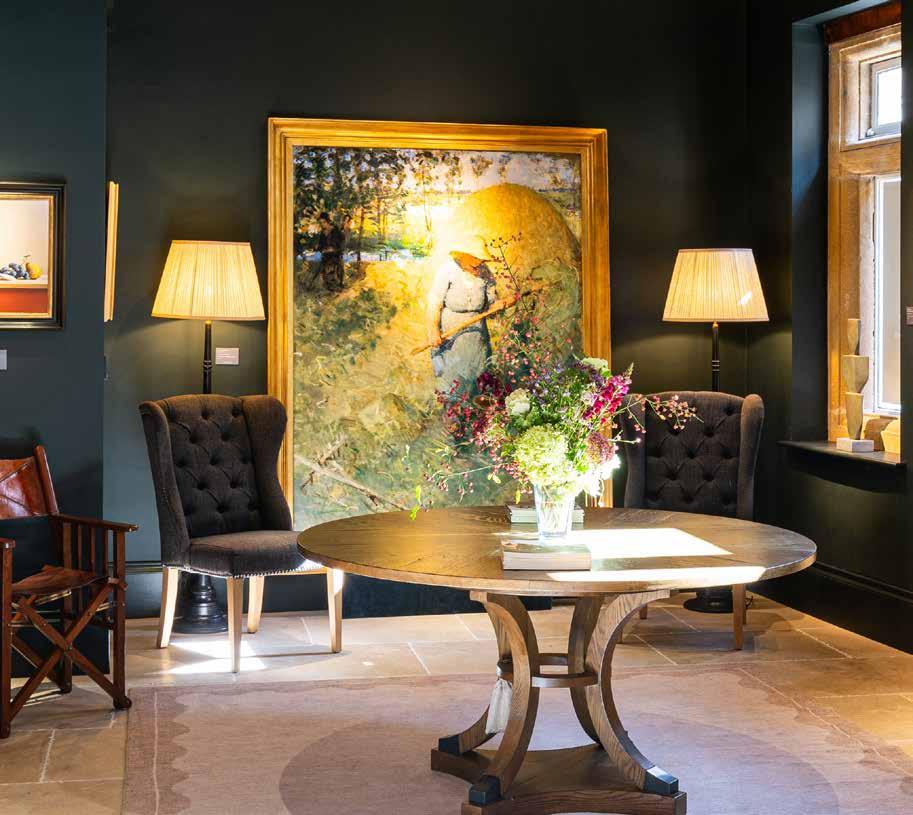

Gladwell & Patterson LAPADA 2025
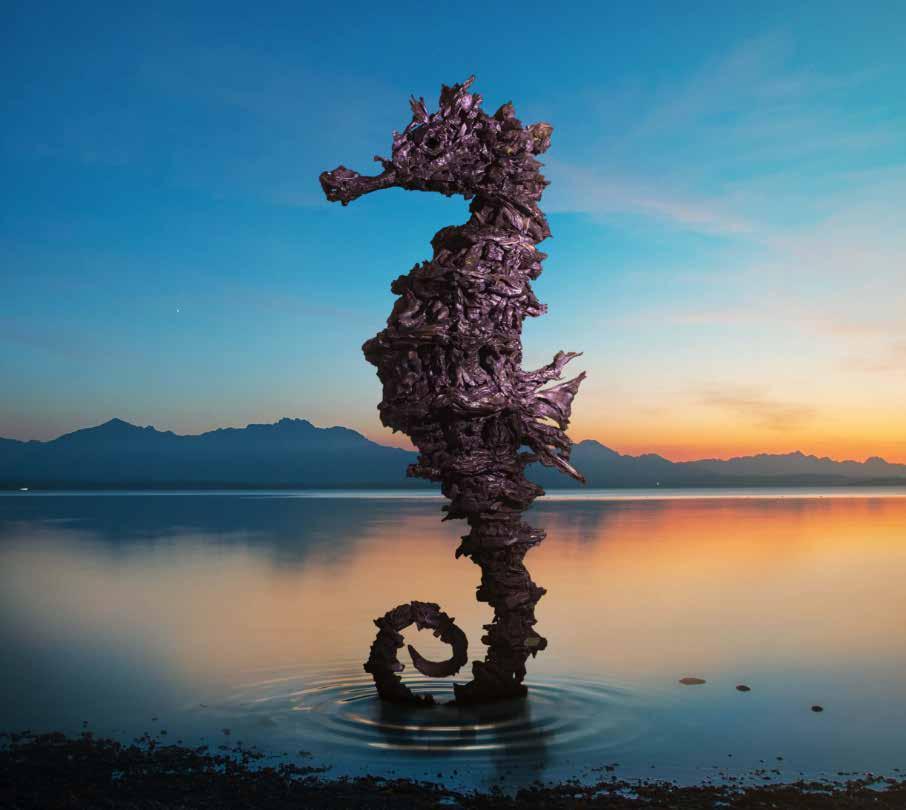
Gladwell & Patterson at LAPADA
Merewyn the Intrepid Traveller, 2025
£10,000
Gladwell & Patterson are delighted to announce our debut at the prestigious LAPADA Fair in Berkeley Square this October. As we join this landmark event in London’s cultural calendar, we look forward to sharing our gallery’s distinctive heritage, expertise and artistry with an international audience, and to welcoming collectors old and new to discover our latest curation. Please come by and visit us on Stand A33.

Stand A33
28th October - 2nd November 2025 Berkeley Square, Mayfair, London.




A GALLERY OF DISTINCTION
Gladwell & Patterson is a family-run fine art gallery with a legacy dating back to 1746. As one of London’s longest-standing art dealerships, we specialise in sourcing exceptional paintings and sculpture from Impressionist, Post-Impressionist and contemporary masters.
• Our history has been a distinguished two and a half century journey. Along the way the various incarnations of Gladwell & Patterson overcame the Blitz and enjoyed the friendship of Vincent van Gogh.
• As you stepped across the historic mosaic doorstep brought down from the Cheapside gallery and reinstalled here – ‘Gladwell’s Corner’, you were stepping into a wonderland.
• Paintings hung floor to ceiling and on every available space on the back of doors and up and down the stairs. A compact and charming space, the gallery was a haven for all who visited. A place of calm amongst the hubbub of the surrounding City.
In recent years the gallery has gone from strength to strength, participating in numerous art fairs world wide. The team have showcased stunning artwork in the United States, Asia, Europe and the United Kingdom, taking the true ‘Gladwells charm’ along with us and meeting many wonderful friends and collectors along the way.







London: Our Legacy
With Emily Campin
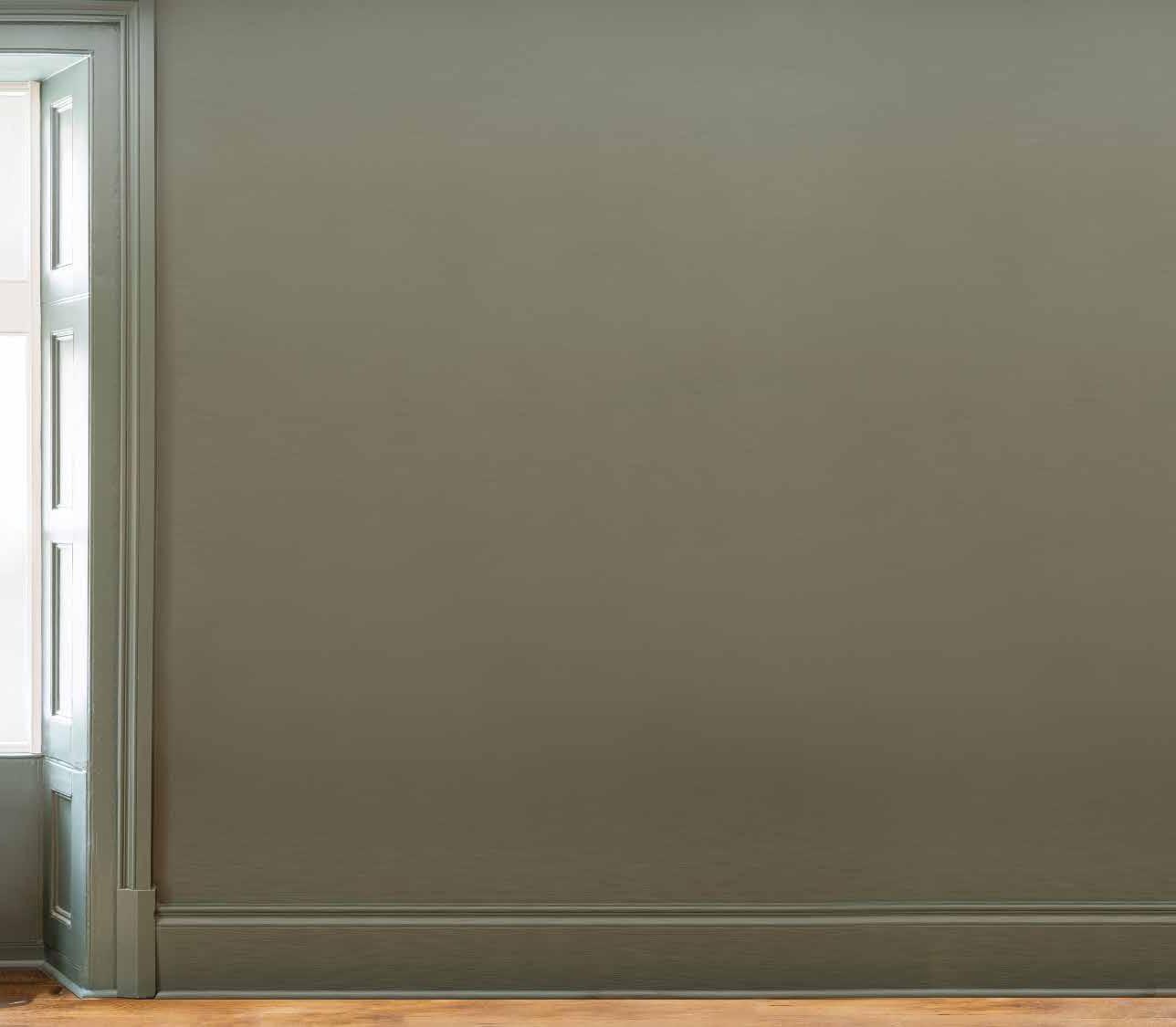
Gladwell & Patterson stands as one of London’s oldest and most prestigious galleries, with a legacy that spans over 275 years. Nestled behind our distinctive monochrome windows on Beauchamp Place, we are proud to reflect on our rich history and enduring presence in the heart of this vibrant city. From hosting unique experiences like our Picasso Pop-up bar to celebrating the works of legendary artists such as David Shepherd, the gallery has consistently been at the forefront of London’s art scene.
Our goal is to find beautiful artworks for exceptional art collections. Nothing gives us greater pleasure.
Q. What makes London such an integral part of Gladwell & Patterson’s identity?
London has been more than just a home to Gladwell & Patterson, it’s been the very heart of our identity for almost 300 years.
London holds a pivotal role in the art market due to its rich cultural history, world-class institutions, and vibrant gallery scene. Home to major auction houses, magnificent hotels, and outstanding restaurants, London is a city with something for everyone.
We love to meet new clients and see familiar faces from all over the world when they visit us at our
Knightsbridge gallery. Whilst we grow and expand our presence across the UK, London will always be home and has a special place in our hearts. Bring on the next 300 years!
Q. What exciting developments are on the horizon for the gallery?
The future is certainly exciting! With a magnificent new gallery in Stamford, which is perfect for hosting and entertaining, we now have two stunning galleries to welcome you to and we hope to be bringing you many more events and exhibitions this year.
We have had the privilege to work with some brilliant luxury brands this year such as Private Cellar, Fromental, and Boodles. A particularly special event was one shared with Boodles at their Mayfair showroom that

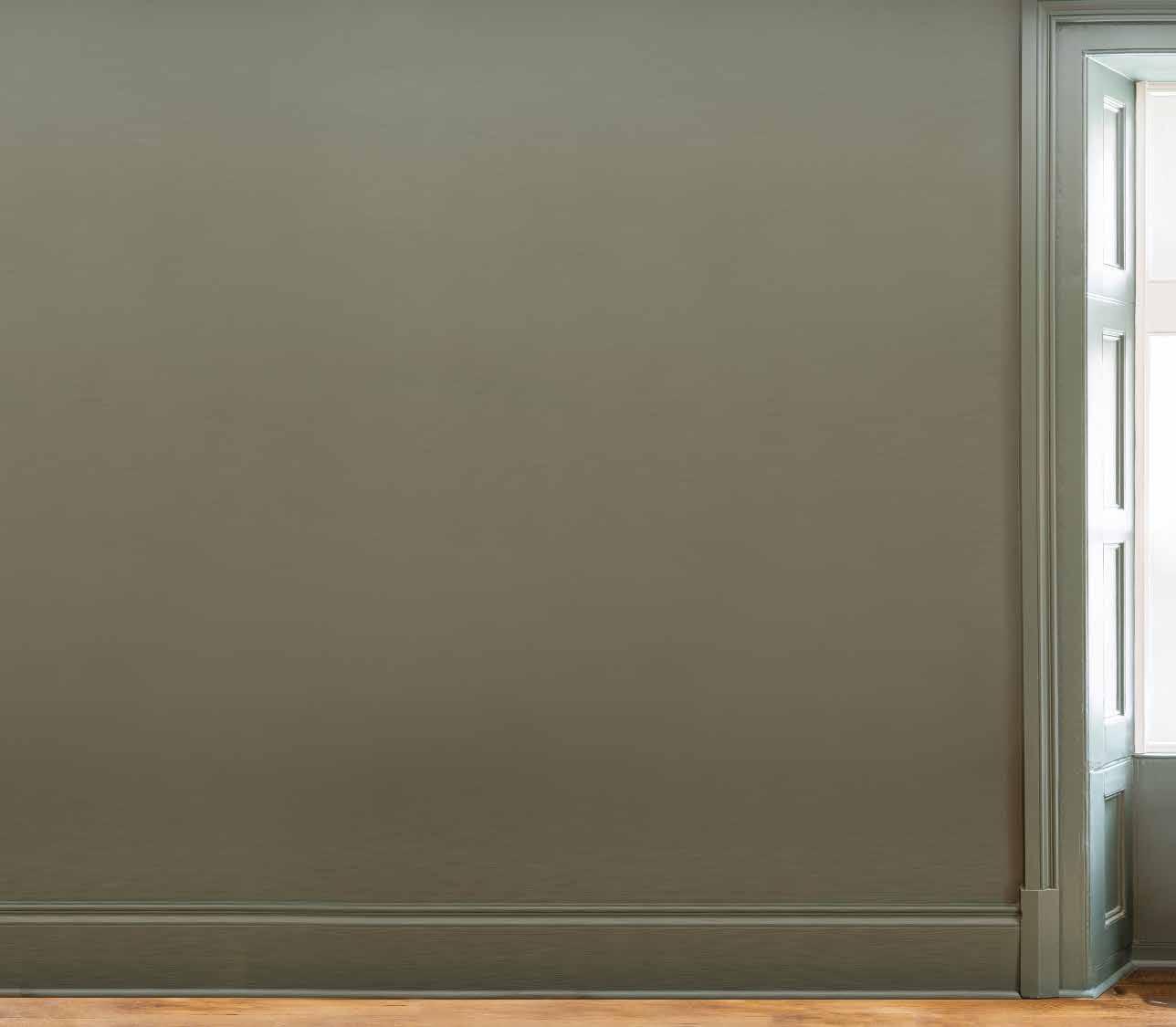
is on the site of our old gallery, W H Patterson on Albemarle Street. It was rather nostalgic hosting an event with them in our old home, celebrating a combined history of over 500 years of business. If you are ever in the area, make sure you pop in and you should find a beautiful painting in their private room downstairs.
Q. What is happening with the UK art market?
The art market is sadly not immune to political uncertainty, but during times of change there are always new opportunities, and we have been lucky enough to acquire some brilliant paintings during this time, and we have the privilege to share these with you and pass on those exciting acquisitions. There is something to be said for enjoying your investments on your walls rather than in a bank account! Despite market fluctuations, the demand for quality art is unwavering, and we’re always excited to bring new pieces into our collection.
Q. Which artists or acquisitions are particularly inspiring you right now?
Our acquisitions director, Marie-Claire, has a talent for sourcing fresh and exceptional artworks. She works closely with our artists and is always on the hunt for new, fresh talent. Trawling the auction websites and private collections worldwide she continues to surprise us with her fantastic buys - most recently a rather unusual yet fantastic tropical fishing scene by Terence Cuneo.
Q. Which international shows are Gladwell & Patterson exhibiting at in 2025?
We love travelling the world with our beautiful paintings and meeting our lovely clients, both old and new. We have a busy schedule for next year, starting with our annual trip to Florida. Our East Coast tours continue with visits to Philadelphia and Newport, Rhode Island.
You may read this and think that there can’t possibility be time for any more shows, but our UK show circuit next year is also looking pretty exciting, with highlights including the RHS Chelsea Flower Show and Burghley Horse Trials.
Q. Have you seen any inspiring museum exhibitions this year?
Van Gogh: Poets and Lovers at the National Gallery in London – a must-see exhibition which really brings to mind Gladwell & Patterson’s legacy with this incredible artist.
Q. What is your favourite painting in the collection?
We are very lucky to have acquired such a special collection of Pierre Eugène Montézin ’s work this year. La Fenaison, a simple scene of workers harvesting the field, comes alive with the afternoon sunlight beating down, creating a shimmering effect that adds a sense of warmth and vitality to the scene. The pops of poppy red that appear in the thick impasto of the foreground are truly brilliant.

Bringing Art to You
With Glenn Fuller

After an intensive nine months of dedicated effort transforming No.1 High Street into a remarkable art gallery, we had the privilege of sitting down with Glenn - one of the driving forces behind the Stamford Gallery - just before he jets off to another Art Fair. Seated in the newly finished Treasure Vault in the basement of the gallery, Glenn takes a moment to reflect on the journey that brought this space to life. Over a glass of Montrachet, we engage in a conversation about the gallery’s evolution, the vibrant art community of Stamford, and the exciting future that lies ahead.
Q. Gladwell & Patterson is a name synonymous with excellence in the art world. What sets the gallery apart from others?
We are proud to have a rich and illustrious history, which provides us with a deep understanding of the essential elements that make our gallery strong and highly respected.. Our dedicated and passionate team work tirelessly to discover the finest artists and paintings, helping our valued and lovely clients build beautiful and enjoyable art collections. This dedication allows us to guide our clients, many of whom have become dear friends,

as they build collections that are personal, meaningful, and enduring.
Q. The gallery’s recent expansion to Stamford represents a significant step forward. How does this fit into Gladwell & Patterson’s longterm vision?
The opening of No. 1 High Street marks a seminal moment for the gallery. By acquiring the freehold, we have created an opportunity for permanence while also challenging the status quo in how paintings are presented.

Our vision for the Stamford gallery was to craft a space where our exquisite paintings could be appreciated in the most enjoyable way possible. Discovering this historic freehold building in such a prime location has provided a lasting and prominent setting for our clients to fully immerse themselves in our collection.
By designing each room with the paintings and sculptures in mind, we’ve ensured that every artwork can be experienced at its best. We hope this inspires visitors to design their own spaces around the art they cherish, deepening their connection to it and enhancing their enjoyment.
Our long-term vision has always been rooted in creating lasting bonds - between art and

people, and between people and place. Stamford, with its beauty and history, felt like the ideal location to continue this journey.
Q. Stamford is a truly special place. What is it about the town that makes it the perfect home for the gallery’s latest venture?
We settled in Lincolnshire ten years ago, shortly followed by Cory and my parents who all now live locally, and it is a wonderful place to live. Stamford has been praised as England’s most beautiful town and the finest stone market town by distinguished figures such as Sir John Betjeman, Sir Walter Scott and Nikolaus Pevsner.
This charming, historic, and vibrant town once served as a gateway between the north and south, making it an ideal location. With easy access from all over the the country, it is a popular destination, easily accessible for local and international art enthusiasts alike.
Q. Can you tell us more about the wider region and why it appeals to you personally?
The area surrounding Stamford is nothing short of breathtaking. Nestled on the edge of some of England’s most picturesque counties and framed by the vast skies of the Fens, Stamford exudes a natural charm, rich history, and timeless beauty.


With quaint English villages nearby and the stunning Rutland Water close at hand, this area offers an abundance of reasons to fall in love with this remarkable part of the country. It offers a quality of life that is in harmony with our values: history, beauty, and a deep connection to place.
Q. Transforming an historic building into a modern gallery must have been a significant challenge. What obstacles did you face during the renovation process?
Transforming this beautiful building, that has been a bank for the last 115 years, with its maze of small rooms and corridors, into a space suited for the 21st century and beyond has been an exciting and enjoyable challenge. One of the trickiest aspects was finding the perfect location for the new staircase
and elevator, elements crucial for creating a seamless flow through the gallery.
One of the first unexpected obstacles arose when we decided to replace the roof of the bank office, a 1980s extension, with a large skylight to bring in abundant natural light. What we didn’t anticipate was that the existing roof was reinforced with 18 inches of reinforced concrete, much to the builders’ dismay! The greatest challenge, however, was balancing our varied opinions and tastes, ensuring that tha e final result was not a compromise but a cohesive vision, and this is something we’re incredibly proud of achieving.
Q. After all the hard work, what aspect of the new gallery are you most proud of?
Everything - absolutely everything - has turned out even better than my most optimistic expectations. Visitors step into the space and are genuinely blown away, a phrase we’ve heard countless times in just the first few weeks. Personally, I’m thrilled with the lighting and how beautifully it showcases the art, the architecture, and the building itself.
Q. What is your favourite painting in the collection?
It’s difficult to choose, as so many of the paintings are shown to their absolute best in this new environment. A new, large Alexandre Jacob piece, for example, looks stunning above one of the new fireplaces—I find myself returning to it again and again. The Paul Brown paintings in the bar area, set against walls and ceilings in Obsidian Green, radiate a sense of quality and richness that’s truly captivating.

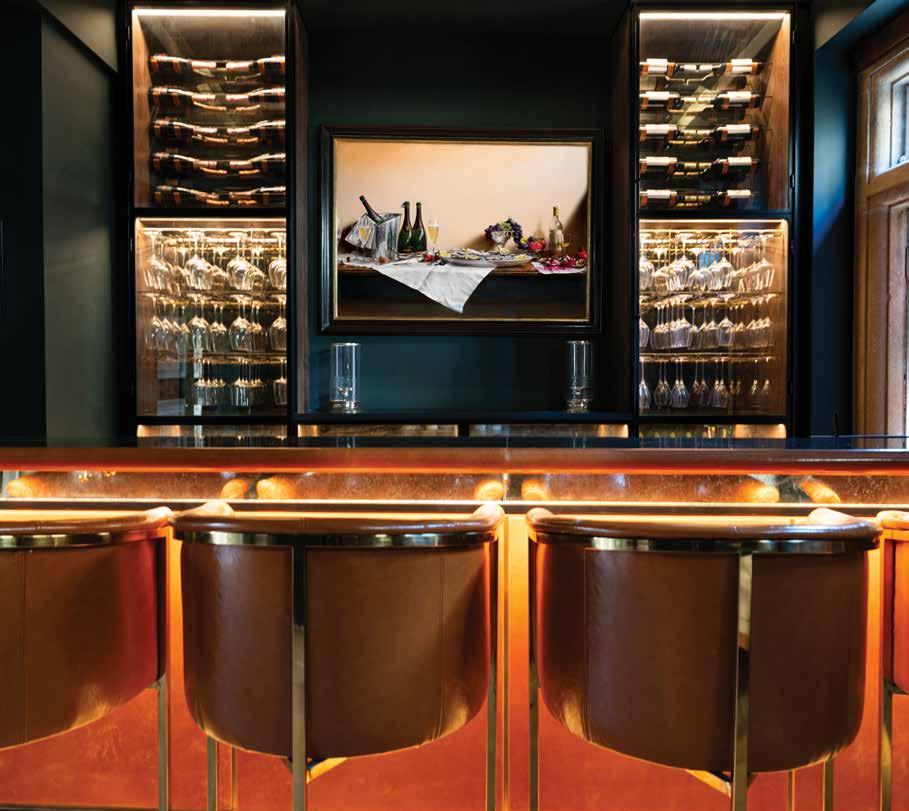
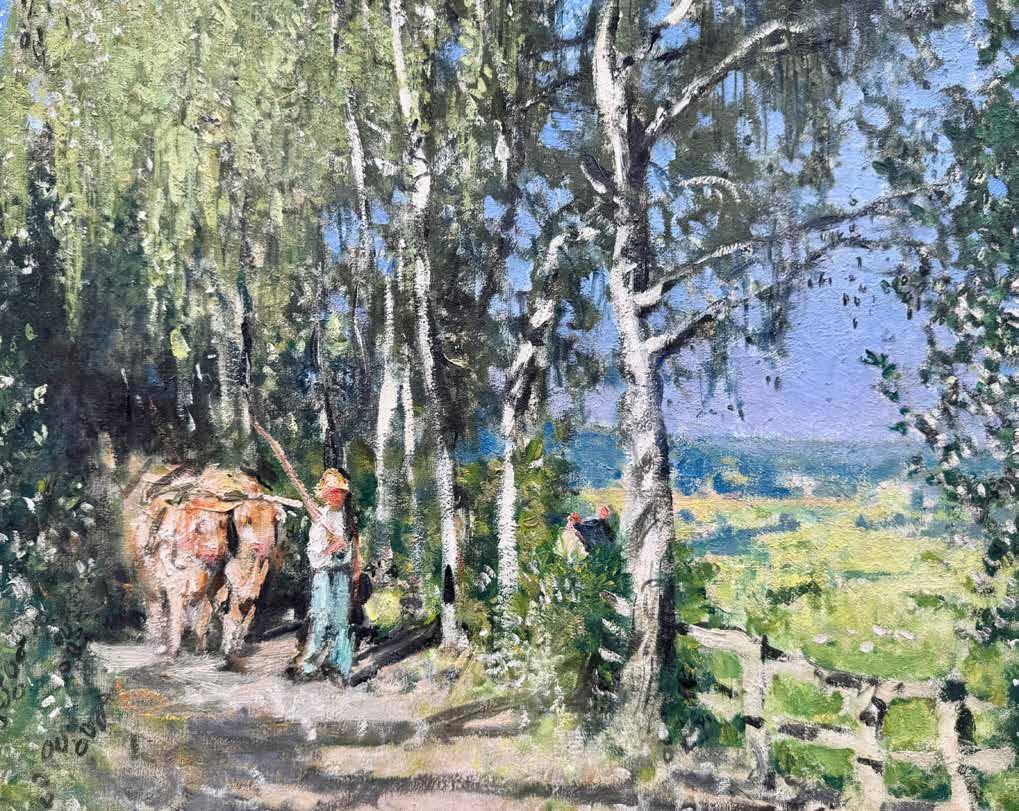
Pierre Eugène Montézin
French (1874-1946)
Paysage Creusois
Oil on Canvas
46 x 55 cms / 18 x 21¾ inches
£23,000
Inspired by the popular subjects of haymakers and peasant workers, which had graced the Salon walls since the times of Jean-François Millet and Gustave Courbet in the mid nineteeth-century, Montézin delighted in capturing the natural landscape as he experienced it. Majestic figures provide a focus to his landscapes, peasants toiling under the heat of the midday sun or blissfully at leisure within the natural environment are often represented in his oeuvre. Montézin played homage to the subjects adopted by the Realists but imbued them with a distinctly Post-Impressionist elegance, showcasing his pioneering approach to his craft.
In this dazzling painting, Montézin merges the traditional Impressionistic influences of Claude Monet and Alfred Sisley with his own techniques. His approach to depicting rural life is highly expressive through his use of colour and application of paint – note the vibrant dashes of red in the poppies. Departing from the highly detailed style characteristic of Realism, Montézin painted spontaneously en plein air to capture the fleeting sensations of light and weather. His rapid, feathered brushstrokes ripple like passages of light, and he uses luminous hues of green and yellow freely, all working to recreate the vibrant atmosphere of a summer afternoon during haymaking season.
Visually commanding, in scale and subject, La Fenaison en Normandie echoes the philosophy of the realist paintings by Corbet and Millet. At the heart of La Fenaison en Normandie is a peasant worker, hard at work under the hot midday sun. Her figure dominates the composition, serving as the focal point around which the entire scene is constructed and elevating the humble subject to the status of history paintings.
Montézin was widely celebrated throughout his career and was awarded numerous awards at the Paris Salon’s. In 1923 he received the Légion d’Honneur for a landscape painting at the Salon des Artistes Français - the first landscape artist to be awarded since 1897. Critical reaction to this nomination was explosive. To elevate landscapes to the major leagues of historical, classical, and figure painting genres after thirty years was a once in a generation triumph.
Montézin’s naturalistic depictions of haymaking were among his most celebrated. Following the success of these works, in 1939 Montézin was commissioned to paint a vast fresco inside the Palais de Justice de Chambéry. The frescoes stand as monumental works that capture Montézin’s ability to convey the dignity and importance of rural labour within the grand context of legal and civic virtue, the pinnacle of his oeuvre.
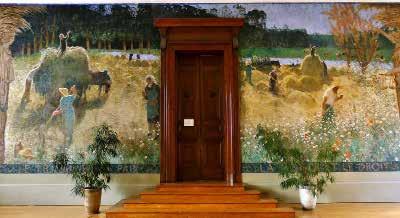
French (1874-1946)

La Fenaison en Normandie
Oil on Canvas
187.5 x 143.5 cms / 73¾ x 56½ inches
£69,000
Les Travaux des Champs, Pierre-Eugène Montézin, Palais de Justice de Chambéry France
Pierre Eugène Montézin
Gustave Cariot
French, (1872-1950)
L’Ombre et la Lumière sur la Meule
Oil on Canvas
60 x 80 cms / 23½ x 31½ inches
£57,500
Golden light bathes the French countryside in L’Ombre et la Lumière sur la Meule where Gustave Cariot elevates a solitary haystack into a radiant emblem of harvest and harmony. The surface glistens with minute, deliberate strokes forming a tapestry of ochre, violet, sage and pearlescent hues, woven together through Cariot’s distinctive adaptation of Divisionist technique. His touch is both precise and lyrical, echoing the quiet pulse of the land as it yields to the long shadows of late summer.
Cariot’s work holds an important position in the evolution of French PostImpressionism. Though aligned with the Pointillists in method, he departed from their scientific rigor to favour a more atmospheric and intuitive approach. A self-taught painter and frequent exhibitor at the Salon des Indépendants, Cariot was admired for his ability to evoke not just the appearance of nature, but its shifting moods across time. Like Monet before him, he created seasonal series that captured the same motif under different lights, an approach seen here in the glowing serenity of this sunlit field.
Painted in the rural outskirts of Île-de-France, this landscape is unpopulated, serene and precise. The haystack anchors the composition, its form softened by the gentle rhythm of field and sky. Trees fringe the horizon in delicate counterpoint, their edges fading into the distance. Every element reflects Cariot’s fascination with nature in flux, a world distilled through light, memory and meticulous observation.


French, (1872-1950)
49.5 x 59 cms / 20 x 24 inches
£39,500
Gustave Cariot
Moisson
Oil on Canvas
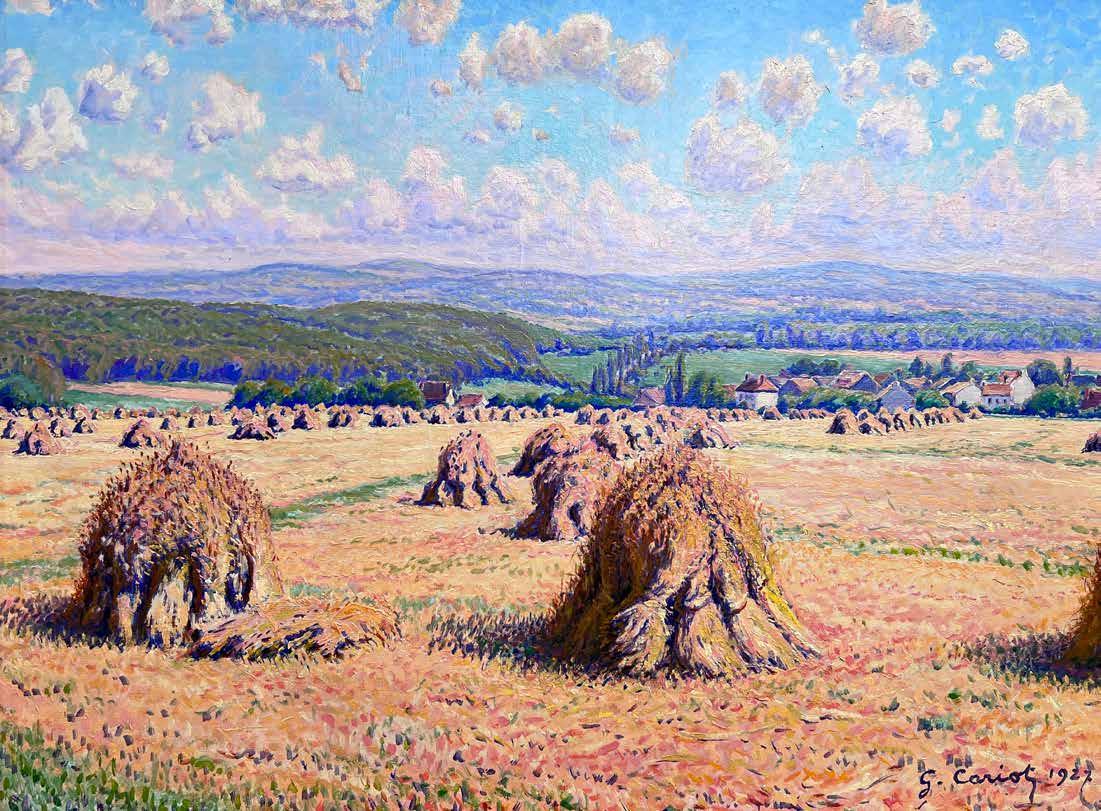
Gustave Cariot
French, (1872-1950)
Meules dans un Paysage Vallonné
Oil on Canvas
60 x 81 cms / 23½" x 31¾"
£65,000

Gustave Cariot
French, (1872-1950)
Moissons au Soir
Oil on Canvas
47 x 79 cms / 18½" x 31"
£39,500
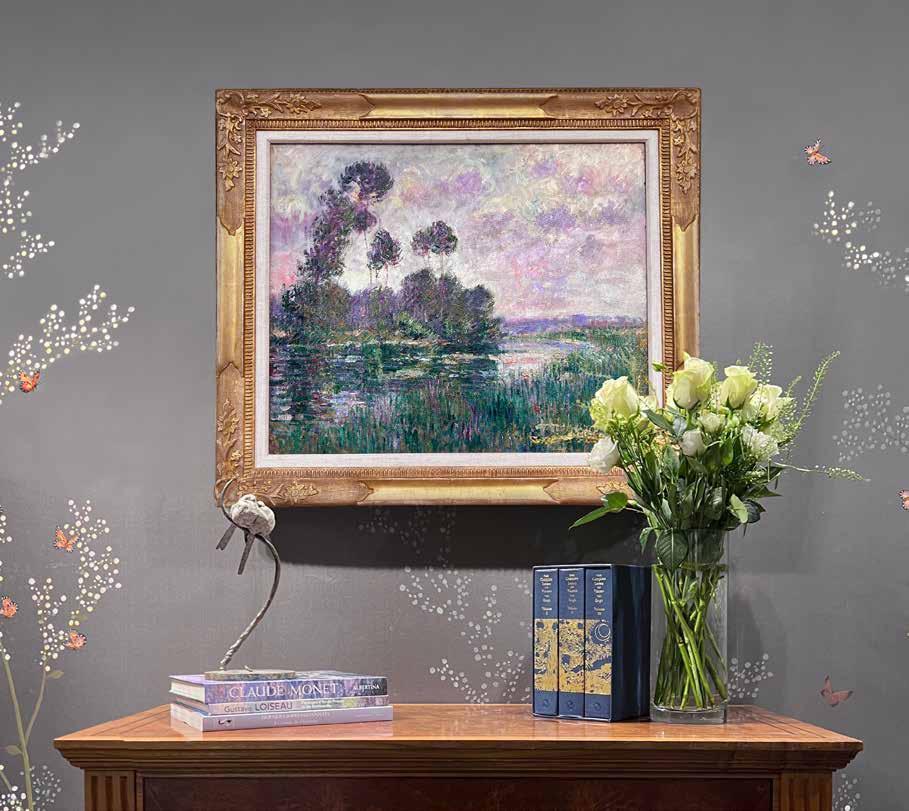
Gustave Loiseau
French (1865-1935)
Painted in 1913 Signed ‘G Loiseau 1913’ (lower right) Oil on Canvas
54 x 65 cms / 21½" x 25¾" Price on Application Provenance
Galerie Félix Vercel, Paris.
Private Collection, Paris; acquired from the above.
Private Collection, by descent from the above.
Sale; Artcurial, Paris, 4th December 2012, lot 65.
Private Collection, acquired at the above sale.
Sale; Sotheby’s, London, 1st Mar 2018, lot 367.
Private Collection, UK; acquired from the above.
The authenticity of this work has been confirmed by Didier Imbert and this work is issued with a certificate of authenticity Bespoke Wallcovering by Fromental
Rivière en Normandie
Gustave Loiseau French
(1865-1935)
Amongst Gustave Loiseau’s oeuvre, no river had a greater influence upon both the artist’s early development and mature mastery than the Eure, and no subject had a greater impact than poplars by a riverside. When Loiseau combined the two: masterpieces such as the stunning Rivière en Normandie inevitably followed. A crucial precondition for the creation of a masterpiece is unparalleled knowledge of subject matter; an artist is rarely able to produce their best works without this understanding. As Monet developed his poplars and waterlilies in a process of continual refinement, so too did Loiseau return to the Eure annually to perfect his paintings. Yet where Monet’s series of paintings largely capture a single point in the artist’s stylistic development, Loiseau’s treatments of the Eure chart the evolution, and culmination, of an entire career.
In fact, while Loiseau is well known for his diverse travels, he would visit the river every year from 1899 to 1932, more than any other location: it is evident that he considered it his best subject, a place in which he felt comfortable truly experimenting. At the start of his career, its riverbanks provided the setting for Loiseau’s richly textured, Pissarroinspired brushwork to emerge and take Paris by storm, and in 1913 the Eure bore witness to an equally startling transformation. Spearheaded by works like Rivière en Normandie Loiseau initiated a campaign of unprecedented colour and expressive brushwork that saw him elevate his technique to new heights.
Painting the river in all seasons and conditions, Rivière en Normandie uniquely captures the complex purple hues of the early evening. The broad expanse of the Eure in the foreground delights the senses as Loiseau superbly captures the rippling effect of wind across the surface of the water, balanced against the movement of the rolling clouds to imbue the painting with an electric energy. Swift brushstrokes dance across the canvas, conveying the deep purples, saturated greens, and bright whites which stand out for their intensity even within the context of Loiseau’s love of saturated colour. Marking a turning point as the artist began to adopt a much freer pictorial approach, Rivière en Normandie is the result of Loiseau working with supreme confidence and skill, a celebration of colour and movement at the apex of his craft.


Gustave Loiseau
French (1865-1935)
Voilier dans le Port de Ferrière, les Martigues
Painted circa 1913
Signed ‘G Loiseau’ (lower left)
Oil on Canvas
46 x 54.8 cms / 18 x 21½ inches
Price on Application
One of the foremost Post-Impressionist painters, Gustave Loiseau was profoundly influenced by the great masterpieces of the Impressionists. A champion of painting the landscape en plein air Loiseau embraced the use of bold colour as he explored and expanded the Impressionist style. Encouraged to paint Martigues by one of his greatest advocates, Pierre-Auguste Renoir, Loiseau ventured from northern France to the idyllic Mediterranean coast in around 1913.
Voilier dans le Port de Ferrière, les Martigues is a captivating depiction of the port. At the water’s edge, the prow of a fishing boat reaches towards the viewer. Feather-quick, angular brushwork carves the pebbled path of the promenade, upon which figures stroll towards us in gentle clutter of dark, rustic hues. The strokes of the sky arc and roll, as if the scene exists inside a pearl. Finally, as the anchor of the painting in its atmosphere and colour, the sea sways in its elongated and textured dashes: tremulous, iridescent, and tranquil.
Voilier dans le Port de Ferrière, les Martigues recalls the atmospheric qualities of the artist’s familiar depictions of the seaside towns and ports of Normandy. The allure of Martigues, with its unique blend of pastel hues and intricate waterways, encouraged Loiseau to explore this new environment, marked by the pastel tones and diffused light. Loiseau captures the melancholic serenity of this setting in his favoured kaleidoscope of delicate indigo, aquamarine, and blush, applied with a much freer pictorial approach, characterised by a looser application of paint and a turn towards increasingly intense pigments. The result is a powerfully atmospheric seascape, painted at the height of Loiseau’s career as the artist is developing into the Post-Impressionist master for which he is renowned.
Gustave Loiseau
French (1865-1935)
Glaçons sur l’Oise
Painted in 1914
Oil on Canvas
60 x 81 cms / 23½ x 32 inches
£89,500
A frozen hush lingers over the River Oise in Glaçons sur l’Oise , painted during one of the coldest winters in northern France. Loiseau presents a rare moment of stillness. The iron bridge of Pontoise anchored across the canvas, while the ice-laden surface of the Oise reflects a pale winter sky. On the far bank, the town is shrouded in quiet; rooftops and chimneys emerge through a veil of cold light, softened by the season’s stillness.
Painted in 1914, this work captures both a moment in nature and a point of rupture in time. That same year, France would enter the First World War. Loiseau’s painting portrays a world momentarily frozen, the calm before the storm. The Pointoise railway bridge would later be destroyed alongside many other canal bridges in the First World War to slow the advancing armies. This painting plays a significant role in the preservation of the French landscape prior to the war, adding a layer of historical resonance that deepens the quiet power held within the painting.
The painting was acquired directly from the artist in
1914 by the legendary dealer Durand-Ruel, who recognised its power and exhibited it in his gallery, a mark of its quality and of Loiseau’s standing among the most significant painters of his time.
Following the success of his first three exhibitions with Durand-Ruel, Loiseau acquired land in Pontoise in 1903, on the banks of the river Oise on the Quai de Pothuis where he proceeded to build his home and studio over the following two years. Pontoise would become an anchor throughout the artist’s life and career, and where he would return in the winter, having travelled extensively during the summer months in Normandy, Brittany and the Dordogne, seeking out suitable subject matters.
At Pontoise, Loiseau followed in the footsteps of Camille Pissarro and Alfred Sisley but forged a distinctive path of his own. Throughout the 1910s Loiseau developed his signature technique, known as en treillis or cross-hatched brushwork, which lends the surface a rhythmic vitality. In Glaçons sur l’Oise he applies this with particular delicacy: cool greys and icy blues intersect with mauves and soft creams, creating a luminous, almost tonal harmony.
As a key figure in Post-Impressionism, Loiseau balanced fidelity to the landscape with a deep sensitivity to the change of weather, time and atmosphere. He had little interest in grand subjects, preferring the everyday poetry of rivers, villages and rural life. This painting is a masterclass in restraint: quiet, contemplative and exquisitely observed. It is a rare opportunity to witness Loiseau at his most introspective, when even the river seems to pause and breathe.

Raymond Thibésart
French (1874-1963)

32.5 x 41 cms / 12¾ x 16¼ inches
£5,500
Marcel Dyf
French, (1892-1953)
55 x 46 cms / 21¾ x 18 inche
£23,000

Vue sur la Côte, Fenêtre Bleue
Oil on Canvas
Roses de Noël
Oil on Canvas
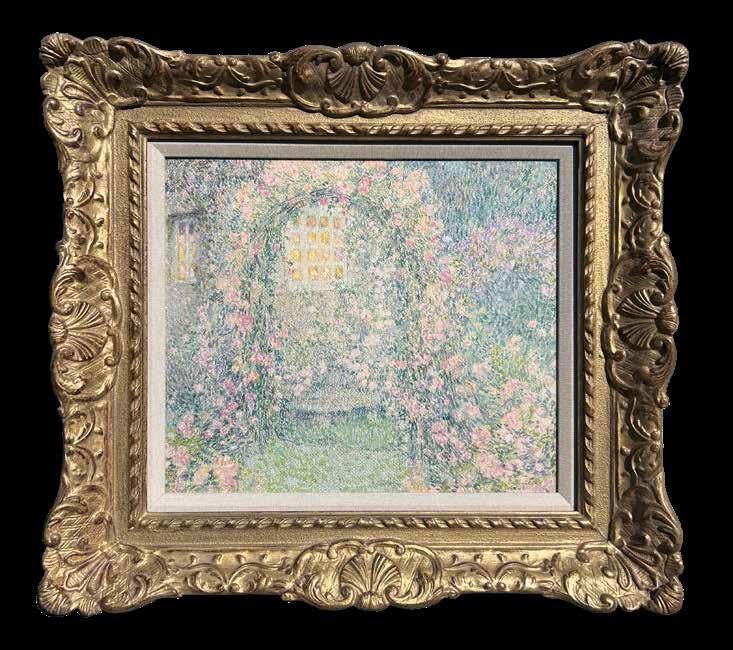
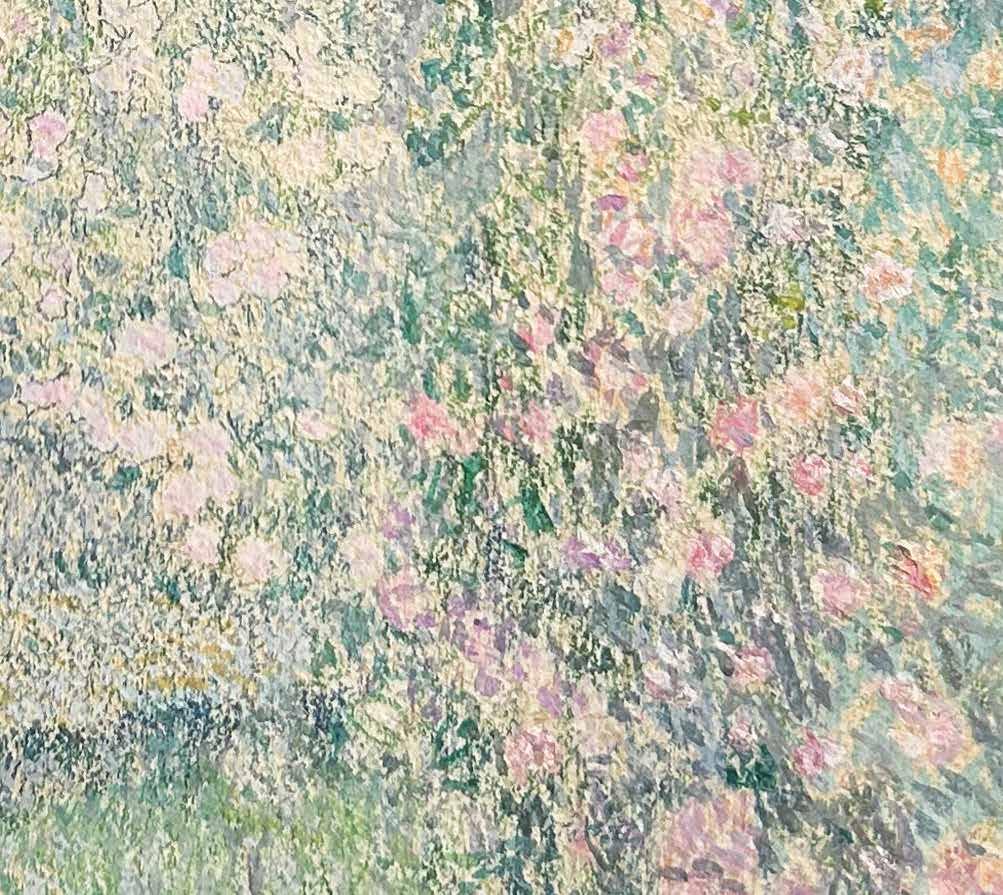
Henri Le Sidaner
French, (1862-1939)
The Rose Garden, Gerberoy
Executed in 1923
Gouache, Coloured Pencils and Pastel on Paper
33 x 40 cms / 13 x 15¾ inches
£85,000

Bathed in the soft half-light of evening, The Rose Garden, Gerberoy is among the most tender and poetic of Henri Le Sidaner’s garden scenes - a twilight reverie captured with gentle precision. Painted at his beloved home in Gerberoy, the work is a tribute to the rose garden he described simply as “the favourite corner of my life.”
Gerberoy, the medieval village Le Sidaner adopted in 1901, became both his sanctuary and enduring muse. There, he transformed a hillside into a sequence of quiet terraces, pergolas and flowering borders, a stage for the changing light and an endless source of inspiration. Between 1901 and 1934, he painted dozens of views of this rose garden, each a study in nuance and atmosphere.
In this delicate work on paper, Le Sidaner renders the pergola with a soft haze of pink, ivory and slate, as if seen through memory or fading light. There are no figures or narrative, only the gentle invitation to pause and observe as forms dissolve into the stillness.
A leading figure of the Intimist movement, Le Sidaner merged Impressionist technique with Symbolist sensibility. He was drawn not to spectacle but to silence and to the poetry of the everyday. The Rose Garden, Gerberoy exemplifies that vision. Intimate in scale, yet rich in mood and meaning; it is a love letter to a place, and to the fleeting beauty of light as day gives way to night.
Henri Le Sidaner French, (1862-1939)
A contemporary of the Post-Impressionists, Henri Le Sidaner’s approach to painting is whole heartedly unique. His technique was often close to Pointillism, but Le Sidaner did not share the Pointillists’ love of colour, preferring greys and opals to create mystery and atmosphere. Instead, he used Pointillist techniques to make the surfaces of his paintings shimmer and blur.
Upon moving to the picturesque hill-top village of Gerberoy in northern France in 1901, Le Sidaner’s seductive views of his gardens, with their recently vacated tables dappled in sunlight and overhung by roses, would cement his reputation as a unique and unclassifiable artist. Le Sidaner spent the summer months in Gerberory but escaped the cold winter’s by travelling elsewhere in France. In 1914 he purchased a second home in Versailles, which quickly became his favorite residence.
While most of Henri Le Sidaner’s works are the products of a single setting, Le Canal et le Pavillon is almost unique in its combination of the parks of Versailles and the artist’s garden in Gerberoy. Understanding the separate influences of these two locales is therefore crucial for an analysis of this work.
Henri Le Sidaner was born in Port Louis, Mauritius, the son of a shipbroker. He spent his early years with his family in the West Indies before they returned to their native France in 1872, first to Dunkirk and in 1880 the family moved to Paris. Le Sidaner studied under the historical painter Alexandre Desmit from 1877 and later gained admission to the studio of Alexandre Cabanel in 1882. In 1882, Le Sidaner visited the Seventh Impressionist Exhibition and became fascinated by the work of Claude Monet. Following one year of military service, Le Sidaner enrolled at the École des Beaux-Arts in Paris from 1884. His enthusiasm for the Impressionist style intensified after attending a retrospective exhibition of Édouard Manet in 1884.
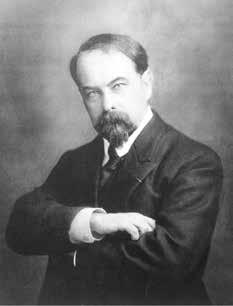
The first generation of Impressionist painters, Claude Monet, Alfred Sisley and Camille Pissarro and Édouard Manet were highly influential to Le Sidaner, whose formative years occurred amidst the height of the Impressionist movement. Le Sidaner’s work parallels that of Monet in terms of style as well as choice of motif; both artists would reiterate the same subject matter in all seasons and during all times of day in order to isolate the variations of light. The Impressionist technique of using short, fragmented brushstrokes and intensified colours was particularly suited to Le Sidaner’s desire to capture the nuances of natural light.
Throughout his studies, Le Sidaner often retreated to the fishing port of Étaples on the northern coast of France to paint, where he felt released from the École's strict routine of copying art in the Louvre. As Le Sidaner himself put it, “Étaples – that is to say, Nature – revived me.” Inspired by the light and air of Étaples, Le Sidaner painted peasant girls in an Impressionist style, inspired by the work of his idols Manet and Monet. These were exhibited at the Salon des Artistes Français in 1887 and were met with great acclaim, by 1891 the Salon had awarded him a bronze medal.
In 1892, Le Sidaner received a grant which allowed him to paint in Florence, Venice and Katwijk in Holland. In 1894 he settled in Paris, transferring his allegiance from the Salon to the more avant-garde Société Nationale des Beaux-Arts. By 1897, Le Sidaner’s canvases were
“His œuvre displays a taste for tender, soft and silent atmospheres. Gradually, he even went as far as to eliminate all human presence from his pictures, as if he feared that the slightest human form might disturb their muffled silence.” 1
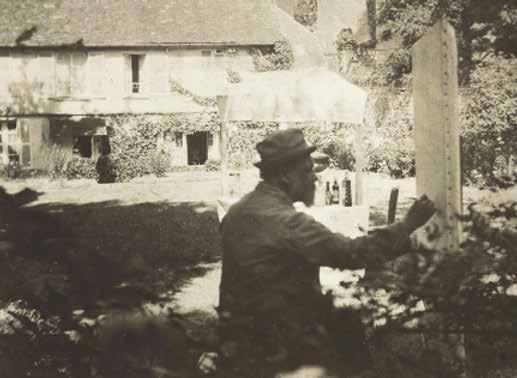
exhibited regularly in one-man shows in Paris, London, Brussels and the United States. He was contacted to both the Mancini Gallery and also the Georges Petit Galleries in Paris where his work was met with great acclaim, with his works becoming increasingly popular with both British and American audiences.
In 1898 Le Sidaner eloped to Bruges with the young Parisian Camille Navarre and it was there that Le Sidaner developed the more personal brand of melancholy that was to make his name. In the nocturne he found an effect of light overlooked by his Impressionist contemporaries, becoming a master of shadow and the velvety darkness of twilight, illuminated by moonlight reflected off snow, water or by a solitary light shining through a window. From around 1900, the artist decisively turned from figurative painting to landscapes, gardens and interiors. He became well known for his moody scenes of urban and rural houses bathed in twilight and moonlight, undisturbed by human figures. He also painted scenes from his own home and gardens. He frequently worked from memory, and in his acute observations and selection from nature his working methods had much in common with those of Whistler.
In 1901, Le Sidaner moved to the picturesque hill-top village of Gerberoy in northern France. After acquiring a small cottage in 1904, he sought to enlarge the building and its grounds in the following years, creating a variety of gardens which appear frequently in his work from this point onwards. His seductive views of the gardens he created in the ruins of the medieval fortress at Gerberoy, with their recently vacated tables dappled in sunlight and overhung by roses, would cement his reputation as a unique and unclassifiable artist. Many followers of Le Sidaner were attracted to Gerberoy and the village soon became re-populated as a colony of artists with Le Sidaner, reluctantly, at its head. The winters in Gerberoy were bitterly cold, and Le Sidaner would therefore spend the winter season in warmer climates such as Chartres, Venice, the South of France and Versailles.
The seductive views he created in the ruins of the medieval fortress at Gerberoy, from recently vacated tables dappled in sunlight and overhung by roses to quiet studies of its houses, would cement his reputation as a unique and unclassifiable artist. It was here that he truly embraced his love of penumbral twilight, leading to the atmospheric and dreamy paintings for which he is best known.
In 1910 Le Sidaner was given a retrospective exhibition at Galerie Georges Petit and the following year he was awarded the Légion d’Honneur. In 1914, a room was devoted to his work at the Venice Biennale.
He purchased a second home in Versailles 1914 and this quickly became his favorite residence. For the remaining decades of the artists life, he painted across France from Brittany to the Côte d’Azur, dividing his time between his homes in Villfrance-sur-Mer, Versailles and Gerberoy.
The environment and the colours of the South of France in particular captivated Le Sidaner and every year throughout the 1920s he would stay in the small, medieval town of Villefranche-sur-Mer. Situated in the heart of the Côte d'Azur, between Monaco, Nice and Cannes, Villefranche-sur-Mer had enthralled the artist since his initial visit there in 1910. Between 1924 and 1928, Le Sidaner lived periodically at the Hôtel Welcome, situated in the centre of the old port overlooking the harbour. It was here that Le Sidaner would create an exquisite series of images recording the still calm and loveliness of the quiet, coastal town that so bewitched him.
Although his technique was often close to Pointillism, Le Sidaner did not share the Pointillists’ love of colour, preferring greys and opals to create mystery and atmosphere, and using their techniques to make the surfaces of his paintings shimmer and blur. He frequently worked from memory, and in his acute observations and selection from nature his working methods had much in common with those of Whistler. Le Sidaner is also often referred to as a Symbolist, although his work largely stops short of the overt imagery of the Symbolist painters, it is the enigmatic feeling of absence in his work that has led to this definition as human figures are only rarely present in his paintings, particularly in his works after 1898.
Inspired by light effects and reflections, Le Sidaner sought to capture his subjects bathed in a diverse range of light, as Monet had done before him. Sunlight, moonlight, and the artificial light of an interior setting appear throughout his oeuvre, but it is his glowing depictions of sunset that resonate with collectors of his work, past and present. The art critic and writer Camille Mauclair described this time of day, when the dying rays of sunlight fill the atmosphere with a soft, ethereal haze, as “Le Sidaner’s time”. 2 Le Sidaner said that no landscape was worth painting unless it was enhanced by some play of light. He was drawn in particular to the play of light on water, which he has captured with his shimmering brushwork and masterful use of tone.
In 1930 Le Sidaner was admitted into the Académie des Beux-Arts, a triumph for a painter who had worked outside official circles for most of his career. His work is found in notable museums across the globe including the Musée d'Art Moderne de Paris. His work is highly sought after and the world record for a painting by Le Sidaner was achieved at Christie’s, New York, in 2022 when La Serenade Venise was sold for $2,100,000, the highest amount ever paid for his work at auction.

Henri Le Sidaner
French, (1862-1939)
The interior depicted here is that of La so/le jaune (The Pink House) - a neighbouring building to Le Sidaner's new house in Gerberoy, which he purchased in 1908. Painted in the following year, La so/le jaune was exhibited at the Ghent Salon, where it received admirable reviews from the local press. Fellow painter Emile Claus wrote to his friend Le Sidaner: "What a marvel you have sent us, this calm and restful Yellow Room with the door open." Ac9uired by a Belgian collector, the work returned to Georges Petit to take part in the triumph of the 1925 Le Sidaner exhibition, where it was bought by the dealer Andre Seligmann. In 1927, Louis Le Sidaner-Henri's eldest son-married and received the house as a wedding gift. It was around this time that he too bought the painting from Mr Seligmann.
Provenance
Galerie Georges Petit, Paris, no. 7395 (acquired directly from the artist on 10 July 1909)
Private collection, Belgium
Sale: Galerie Giroux Brussels, 3 May 1924, lot 48
Galerie Georges Petit, Paris, no. 11157
Andre Seligmann, Paris Louis Le Sidaner, Paris
Galerie Lorenseau, Paris Galerie Flavian, Paris
Collection of Martin S. Weseley, Brooklyn
Sale: Sotheby’s London, 28 June 1972, lot 53
Collection of U. Eviatar (ac9uired at the above sale)
Exhibited
Salon de Gand, 1909, no. 210
Paris, Galerie Georges Petit, Exposition Le Sidaner, 1925, no. 8
Paris, Musee Galliera, Retrospective Le Sidaner, 1948, no. 118
Brussels, Galerie Brachot, Retrospective Le Sidaner, 1951, no. 4
Paris, Galerie Loren<seau, Tables et fenetres d'Henri Le Sidaner, 1952, no. 15
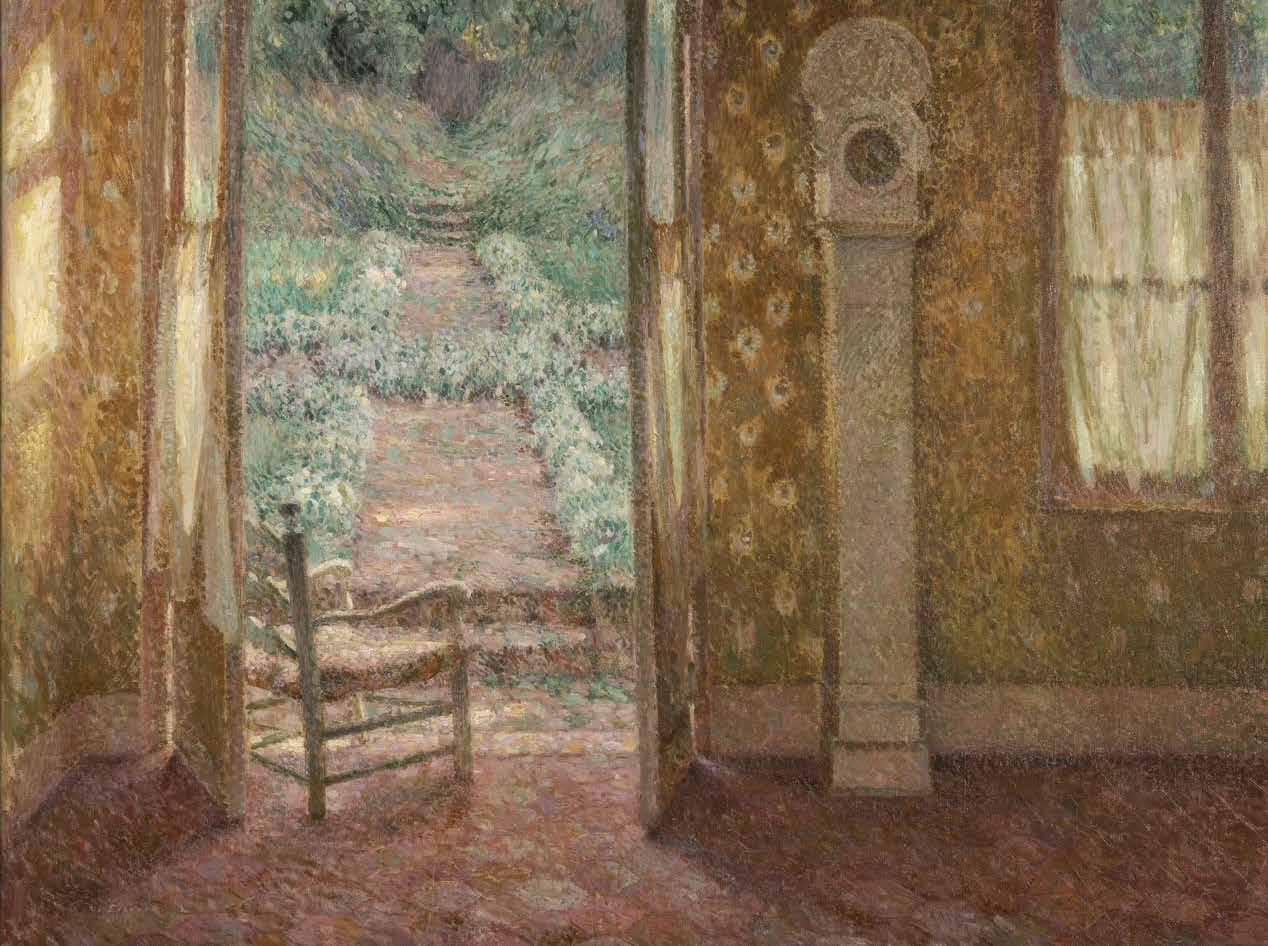
La Salle Jeune, Gerberoy
Executed in 1909
Oil on Canvas
88.9 x 116.8 cms / 35 x 46 inches
£395,000

Henri Le Sidaner French, (1862-1939)
La Canal et le Pavillion
Executed in 1914
Oil on Canvas
65 x 81 cms, 25½ x 31¾inches
£250,000
Provenance
Georges Bergaud (director of the Galerie Georges Petit).
Louis Loucheur; acquired from the above.
Private Collection, France.
Sale; Salle Galliéra, Paris, 18 June 1961, lot 51.
Private Collection, France.
Gladwell & Patterson, London, acquired from the above in 2022.
Literature
Yann Farinaux-Le Sidaner, Henri Le Sidaner: Paysages Intimes (Editions Monelle Hayot, 2013), n°355, reproduced p.146.
Raymond Wintz
French (1884-1956)

54 x 65 cms / 21¼ x 25½ inches
£5,950
46 x 55 cms / 18 x 21¾ inches
£4,950
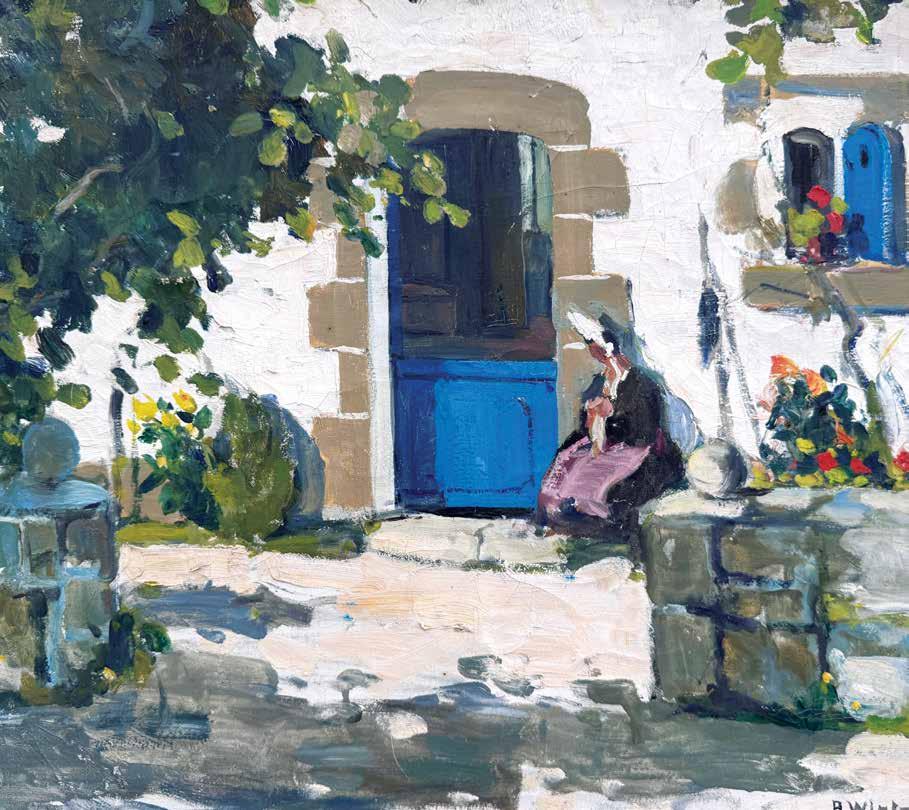
Dans la Cour du Manoir, Finistère
Oil on Canvas
Right Page: Bretonne devant sa Porte
Oil on Canvas

Edward Seago
British (1910-1974)
Low Tide at Bawdsey, Suffolk
Oil on Board
39.5 x 59 cms / 15½ x 23¼ inches
£59,500
Edward Seago’s serene British landscape of Low Tide at Bawdsey, Suffolk captures a fleeting, tranquil moment along the Suffolk coast, where land, water and sky meet in quiet harmony. The painting distils Seago’s deep connection to East Anglia, a region he knew intimately and returned to often, into a composition of remarkable balance, atmosphere and restraint.
Across the canvas, the eye is drawn first to the vastness of the sky. Painted with fluid, expressive strokes, it is luminous yet weightless, a dome of soft light that hovers above the shoreline. Below, the reflective water gently breaks against the mudflats, where moored boats sit suspended between sea and sky. The scene is still, but never static, there is a sense of shifting tide and of weather passing through.
Bawdsey, a small village where the River Deben meets the North Sea, was among Seago’s favoured subjects. Its working shoreline, wide estuary views and ever-changing light provided the perfect setting for his plein-air sensibility. Here, the palette is cool and harmonious, greys, blues and warm earth tones held in careful tension.
Though entirely grounded in place, Low Tide at Bawdsey, Suffolk is ultimately a painting of atmosphere. With elegant economy, Seago invites the viewer to pause, to watch the boats drift, to trace the light across the sky and to enter into the rhythm of tide and time.
Edward
Seago
British (1910-1974)
Landscape Near Blythburgh, Suffolk
Oil on Board
39.5 x 59 cms / 15½ x 23¼ inches
£37,500
Soft light filters across the fields near Blythburgh, illuminating the Suffolk countryside in one of Edward Seago’s most contemplative scenes. Windswept trees bend gently in the foreground, silhouetted against a sky in flux: clouded, luminous and expansive. The land undulates toward the horizon in rhythmic furrows and scattered hedgerows, touched by fleeting glints of sun.
Seago frequently visited the Blythburgh’s tidal estuary, where the rolling fields and wide skies offered him the perfect inspiration for mood and atmosphere. This painting captures the area’s elusive beauty - the stillness after a storm and the hush before the weather turns again. The eye is drawn along a diagonal path from land to sky, from the intimacy of foreground texture to the airy vastness above.
Executed with Seago’s signature blend of looseness and control, the brushwork here is confident and textured. Clouds are shaped with sweeping gestures, while the land is described with firmer, more deliberate strokes. Subtle modulations of colour, from pale blues to ochres and mossy greens, give the composition both structure and softness.
Seago’s art has always resided in restraint. Rather than dramatise the landscape, he invites the viewer to experience it slowly. In this quiet moment near Blythburgh, he offers a mood, a memory, a feeling held gently in paint.
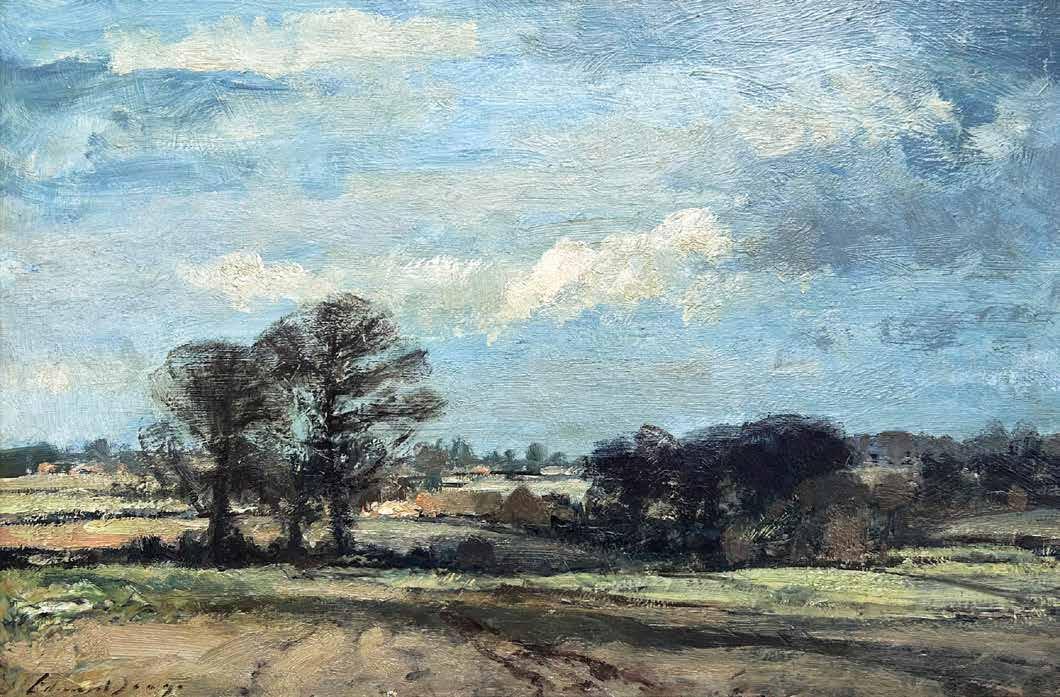
David Shepherd British (1931-2017)
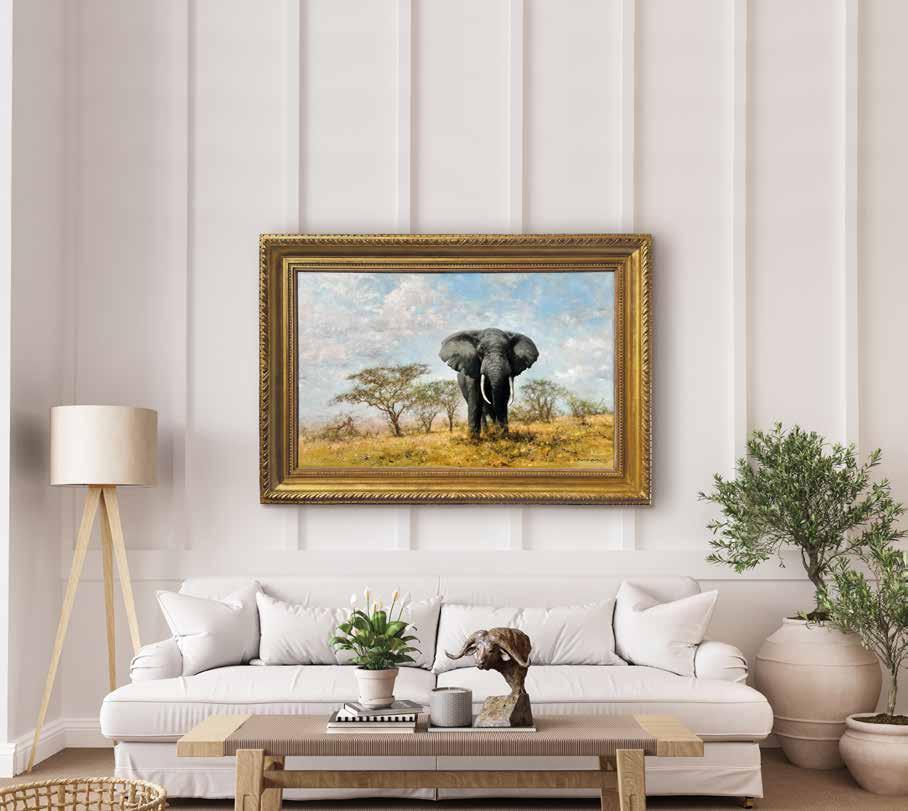
Wolong Panda
Painted in 2006
Oil on Canvas
66 x 51 cms / 26 x 20 inches
£69,000
The Mighty Giant Painted in 1976
63.5 x 101.5 cms / 25" x 40"
£95,000

David Shepherd British (1931-2017)


23 x 40.5 cms / 9 x 16 inches
Elephants in the Savannah
Painted in 1986
Oil on Canvas
£39,500
The Watch Oil on Canvas
30.5 x 51 cms / 12 x 20 inches
£39,500
André Hambourg
French, (1909-1999)
Midi, Beau Temps
Painted in 1969
Oil on Canvas
27.5 x 46.5 cms / 10¾ x 18¼ inches
£23,000
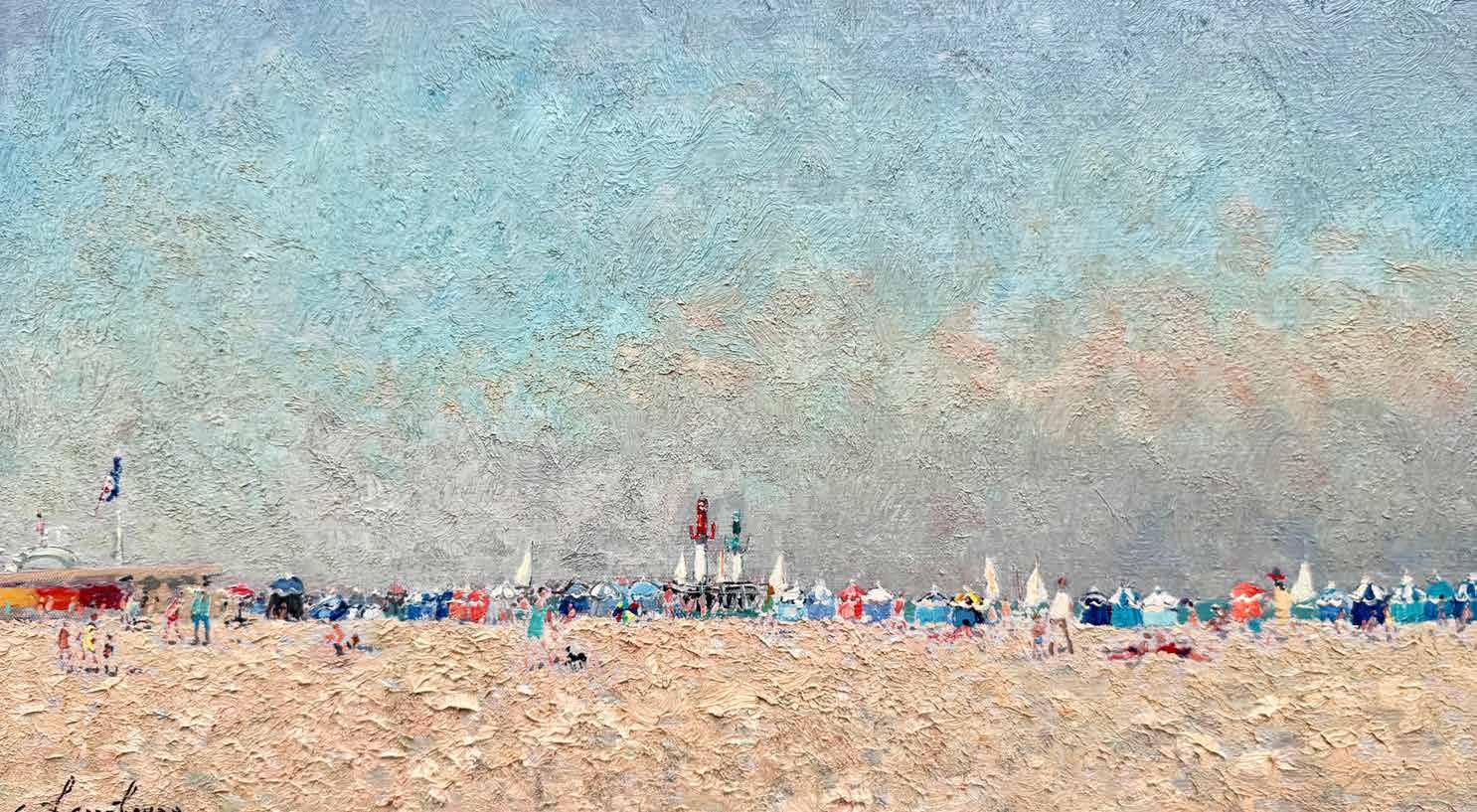
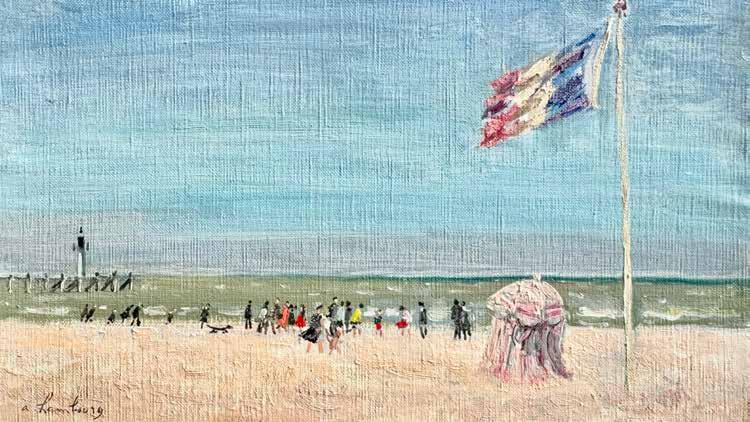
André Hambourg
French, (1909-1999)
Vent du Nord, Trouville
Oil on Canvas
15.5 x 27 cms / 6 x 10¾ inches
£6,950
Adrien
French, (1875-1963)
65 x 81.5 cms / 25½ x 32 inches
£12,500

Hamon
Port of Collioure
Oil on Canvas
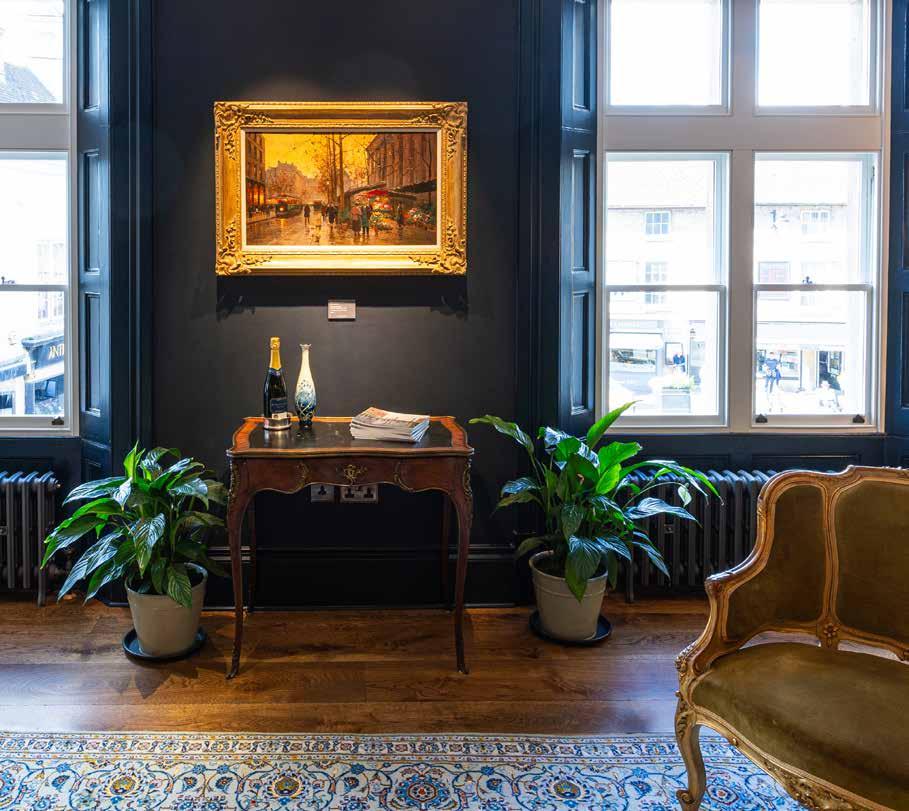
Édouard Cortès
French, (1882-1969)
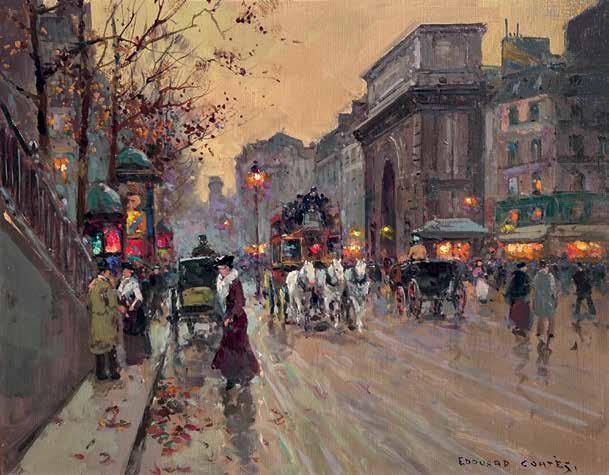
Marché aux Fleurs, Place de la Madeleine, Paris
46 x 76 cms / 18 x 30 inches
£89,500
£55,000
Porte St. Martin
Oil on Canvas
46 x 61 cms / 18 x 24 inches
Left:
Oil on Canvas

Édouard Cortès
French, (1882-1969)
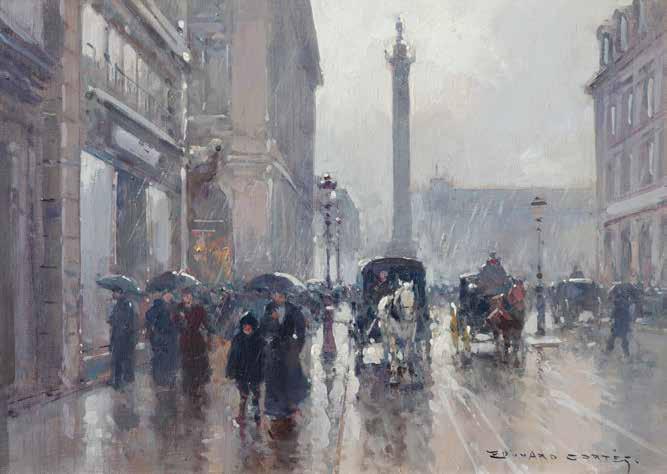
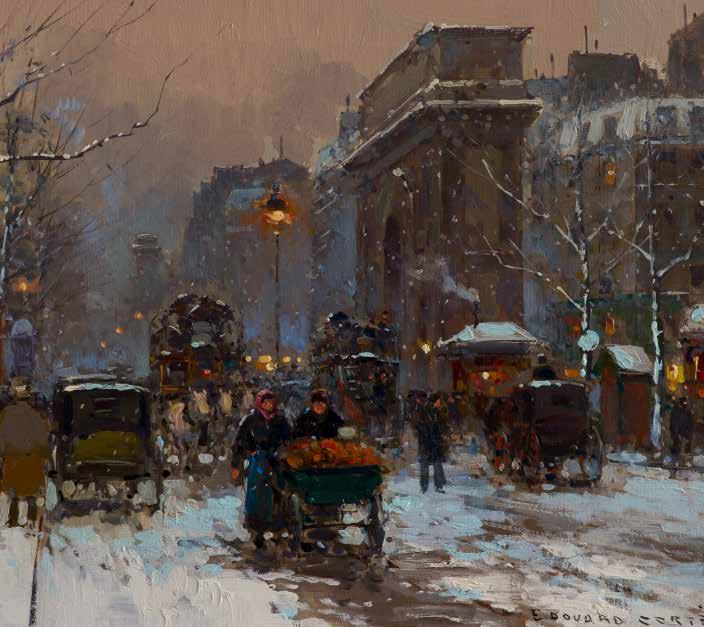

Porte St. Denis, Paris
Oil on Canvas
33 x 46 cms / 13” x 18”
£59,500
Rue de la Paix, Paris
Oil on Canvas
33 x 46 cms / 13” x 18”
£59,500
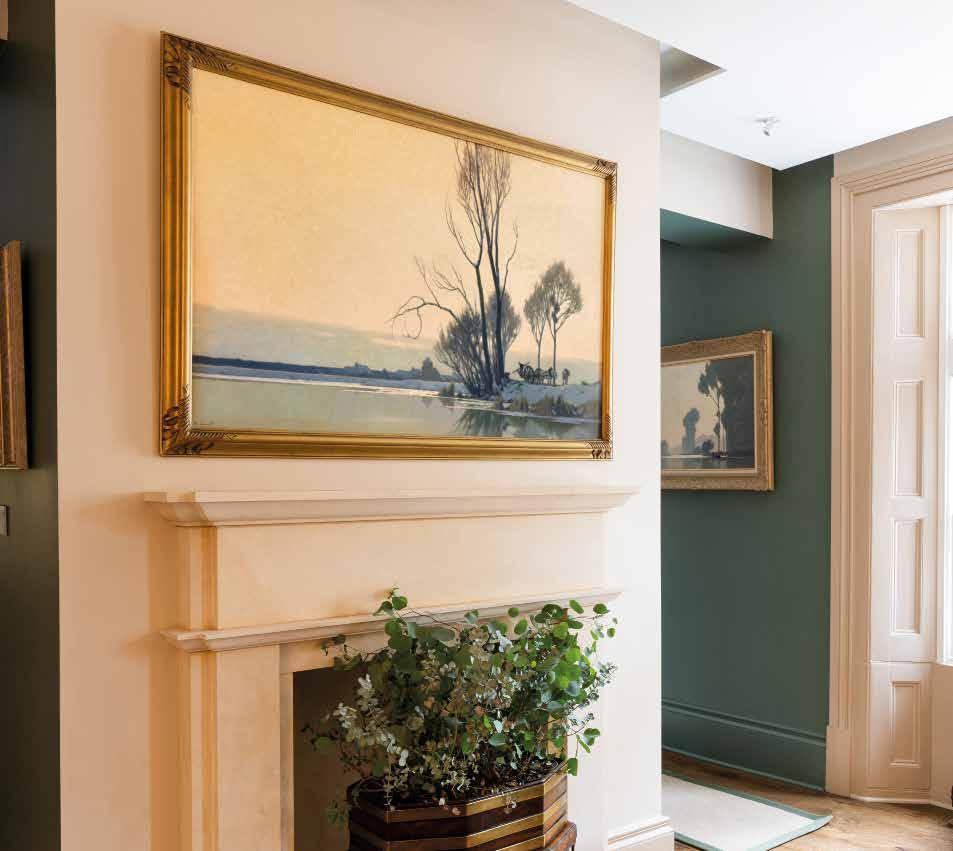
Alexandre Louis Jacob French (1876-1972)
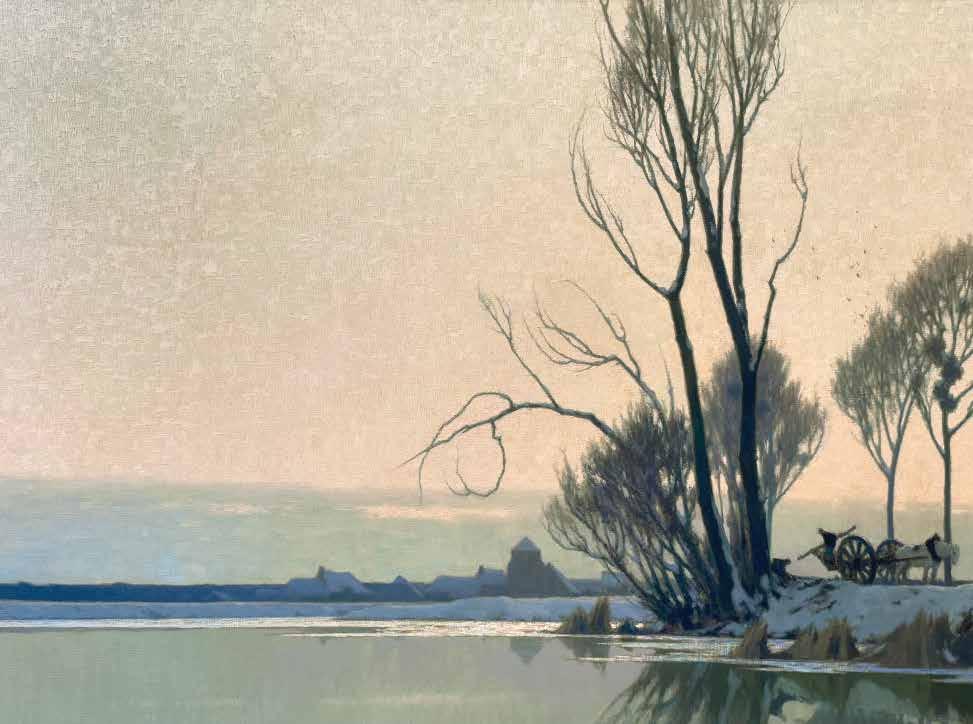
Aube d’Hiver
Oil on Canvas
81.5 x 132 cms / 32 x 52 inches
£36,000
Celebrated for his tranquil landscapes of northern France, Alexandre Louis Jacob is an artist whose legacy is deeply intertwined with our gallery’s esteemed history. Initially discovered by Herbert Fuller, Cory and Glenn’s grandfather, at the Paris Salon after World War II, almost 75 years later, his work remains a constant source of delight to all those that encounter Gladwell & Patterson, in the UK or overseas.
Jacob’s Aube d’Hiver is a mesmerising portrayal of the French countryside at dawn. This winter landscape reflects Jacob’s penchant for capturing the ephemeral qualities of light, a signature element that permeates much of his work. The sky dominates the composition, stretching across the canvas with a soft orange glow.
Jacob’s masterful handling of the early morning light infuses the scene with a sense of quiet anticipation, as if the day itself is holding its breath, waiting for the world to come alive.
Jacob invites the viewer to pause and appreciate the simple, yet profound, moments that make up the tapestry of everyday existence. Through his skilful use of light and colour, Jacob creates a landscape that is both intimate and expansive, capturing the timeless beauty of the French countryside at the break of day.

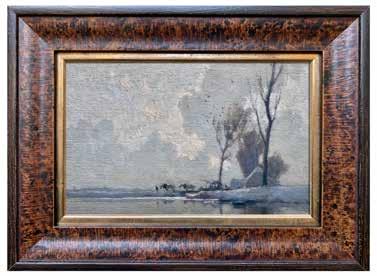
Alexandre Louis Jacob French (1876-1972)
Riverscene with Horse and Waggon
Oil on Panel
14 x 22.9 cms / 5½ x 9 inches
£3,950
Riverscene with Two White Horses towing beside River
Oil on Panel
14 x 22.9 cms / 5½ x 9 inches
£3,950
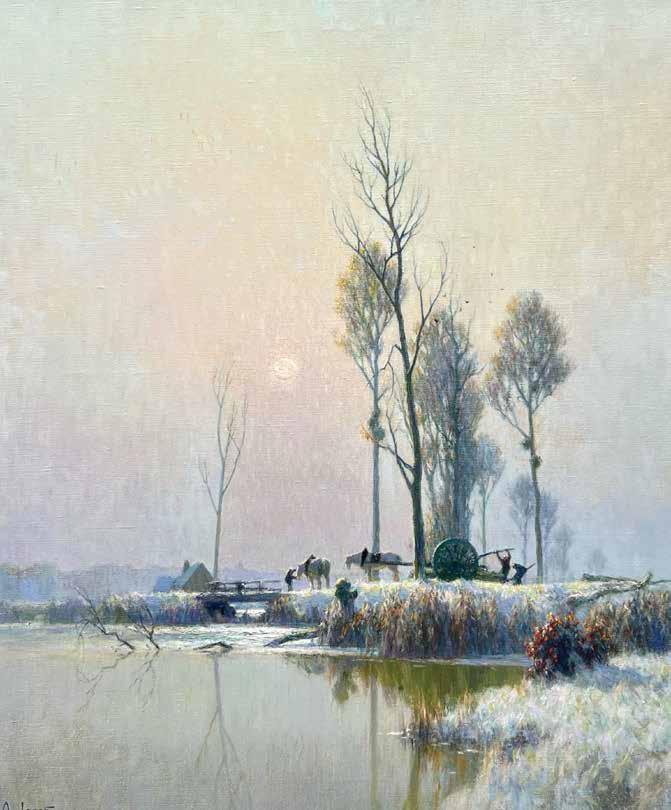
Soleil dans la Brume, un Matin de Givre, Bûcherons
Oil on Canvas
66 x 53.5 cms / 26 x 21 inches
£25,000

Anthony Theakston
British (Contemporary)
Known for his distinctive style and profound appreciation of the natural world, Anthony Theakston has carved a unique niche in British contemporary sculpture. His work is celebrated for its graceful forms, meticulous craftsmanship, and an emotive resonance that transcends mere representation.
Each sculpture is a testament to his skill and vision, capturing the essence of his subjects with elegance and subtlety. Theakston’s sculptures often draw inspiration from avian forms, showcasing his fascination with the grace and fluidity of birds in motion. His ability to distil the essence of these creatures into simplified, abstracted forms is nothing short of remarkable.
Theakston works in his studio overlooking views of the River Trent and British farmland; a landscape that never ceases to inspire. Quick, rough sketches of direct observations from nature are rapidly transformed into a myriad of shapes and elegant lines. Before casting his sculptures in bronze, Theakston hews his models out of blocks of plaster in a reductive process.
The bronze medium, with its rich history and enduring qualities, allows Theakston to imbue his sculptures with a timeless presence. His meticulous attention to detail and the tactile quality of his work invites viewers to engage with each piece on a sensory level. Cast at the worldrenowned bronze foundry Castle Fine Arts Foundry in Wales, the patinas Theakston employs add depth and character, enhancing the organic feel of his sculptures.
As one of the UK’s leading sculptors, we are delighted that Anthony is part of the Gladwell & Patterson’s family of highly talented artists. His distinctive bronze masterpieces are inspired by the sculptural shape, elegance and movement of the bird form using angular and geometric shapes and sit harmoniously in the home and in the outdoors alike.
Large Turnaround, 2025
Bronze, Edition 1 of 6
173 x 27 x 27 cms / 68 x 10¾ x 10¾ inches
£25,000


Anthony Theakston British (Contemporary)

Bastion Original
Bronze, Edition 12 of 12
72.5 x 27 x 21.5 cms / 28½ x 10½ x 8½ inches
£9,300
“My art and activity is a continued process of distilling, where ideas and feelings are concentrated, refined and simplified until, if successful, they have a purity which is no longer about me or the design or the age we inhabit.”
- Anthony Theakston, 2019
Serenity
Bronze, Edition 3 of 12
70 x 15 x 15 cms / 27 ½ x 6 x 6 inches
£8,900
Serenity
Bronze, Edition of 12
43 x 9.5 x 9.5 cms / 17 x 3 ¾ x 3
£5,950


Anthony Theakston British (Contemporary)

Left:
Original Bastion Large
Bronze, Edition of 12
72.5 x 27 x 21.5 cms
28½” x 10½” x 8½”
£9,300
Right: Bastion 3 Small
Bronze, Edition 1 of 6
33 x 7.5 x 7 cms
13” x 3” x 2¾”
£3,500
Stealth
Bronze, Edition 11 of 12
40 x 36 x 11 cms / 15 ¾ x 14 ¼ x 4 ¼ inches
£5,900

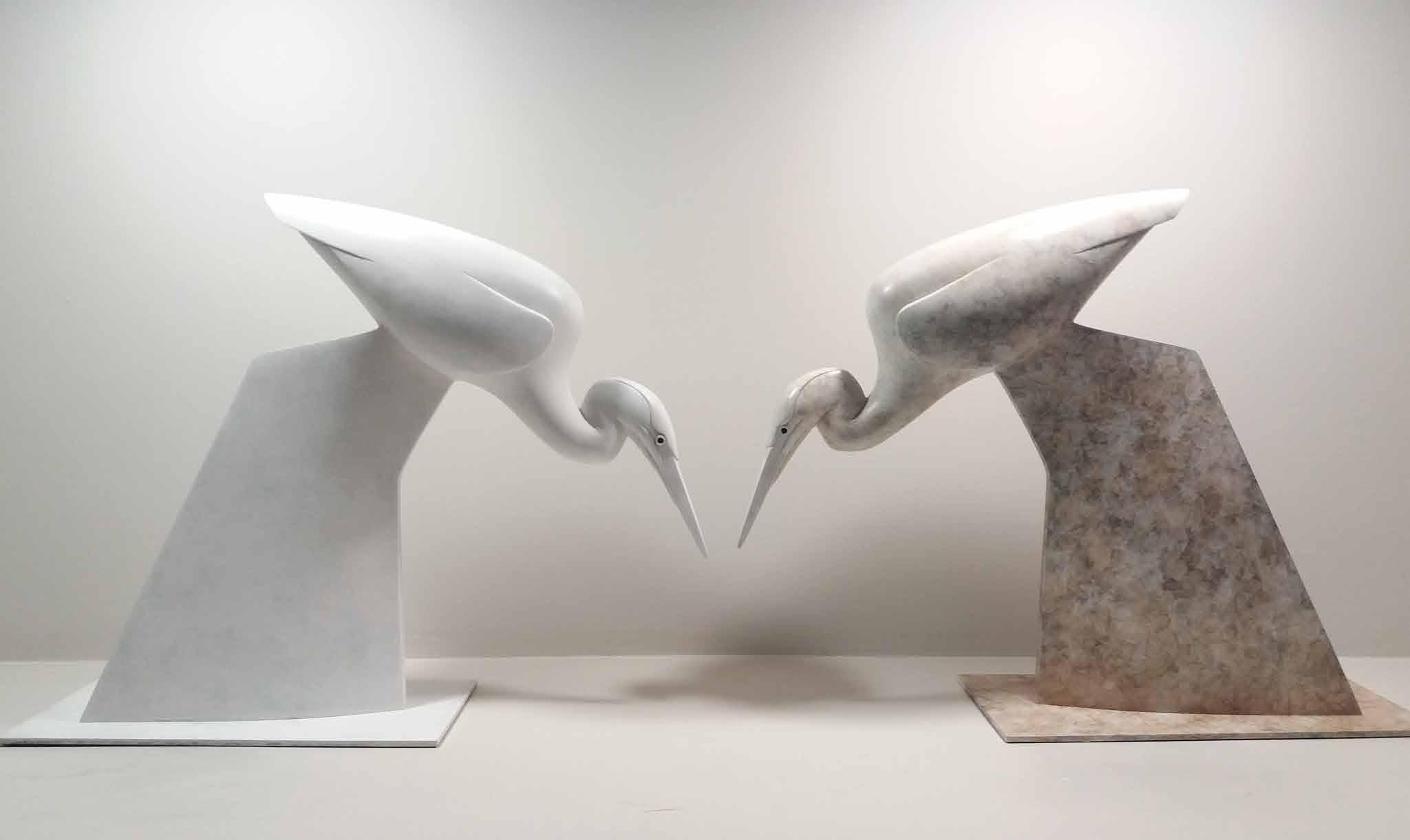
Stalking Heron, 2025 Bronze, Edition 7 of 12
x 38 x 11 cms / 11 ¾ x 15 x 4 ¼
£4,350
Anthony Theakston
British (Contemporary)
Bronze, Edition 8 of 12
68 x 52 x 15 cms / 26 ¾ x 20 ½ x 6 inches
£8,670
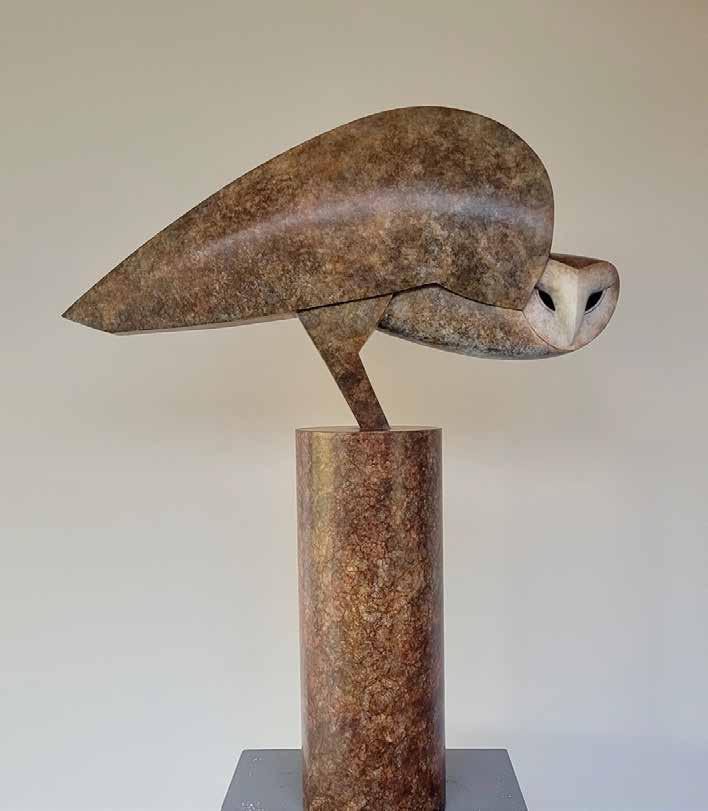


Theakston British (Contemporary)
Bronze, Edition 3 of 12
43.5 x 38 x 14 cms / 17 x 15 x 5½ inches £8,050
Bittern
Anthony
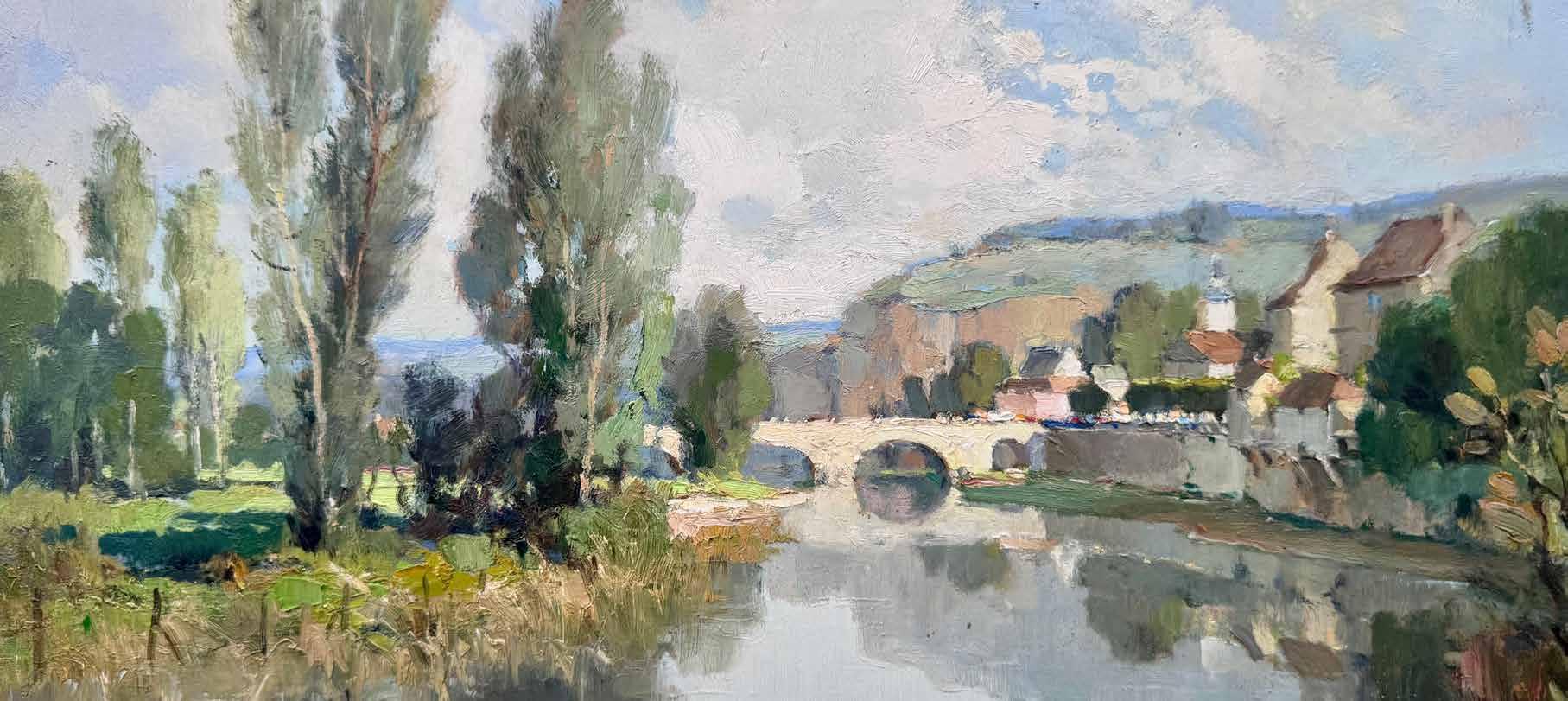
Georges Charles Robin French (1903-2002)
A Collection of Masterpieces


Georges Charles Robin
French (1903-2002)
Georges Charles Robin (1903-2002) was born in Paris. He studied at École des Beaux-Arts under the master painter Paul Michel Dupuy, a noted artist whose paintings are to be found in the collection of the Musée du Louvre. Robin went on to become a well-known decorative artist, before securing a job as the scenery artist for the Charleville Theatre and the Dinan Casino.
Robin lived in the affluent suburb of Rueil Malmaison on the western outskirts of Paris throughout his life. The summer months were often spent near Morlaix in Brittany where Robin had a second home; there he would capture idyllic seascapes and charming river estuaries bathed in sunshine. However, throughout Robin’s career the Loire Valley and the Dordogne region inspired his greatest works.
Enthralled by the enchanting river valleys of rural France that flowed through the luxuriant countryside and rolling fields, Robin’s paintings perfectly capture rural French life. Recognised as one of the best, but largely undiscovered, Post-Impressionist artists of the twentieth-century, Robin’s skill and complete command of his palette set him aside from his contemporaries.
Following the ‘en plein air’ practice of the Impressionist masters, in a few swift brushstrokes Robin brought life to the trees and rivers of the French countryside. Robin was a master at capturing the change in temperature and atmosphere. His restrained use of colour allowed him to capture a warm summer’s afternoon or a blanket of snow with profound skill. Combining his deft and delicate touch with vigorous, dramatic brushstrokes and palette knife work, he produced exceptional landscapes. Robin's skill in emphasising nature's basic structure and his sympathetic interpretation using pure colouring only enhances his total control of the medium of oil paint. His love of nature in all her moods inspires a fine sense of permanence in his craft and his treatment of the rustic architecture that exists in many of the towns and villages of France is unrivalled.
Robin was a member of the Salon des Artistes Français, the Salon des Paysagistes Français, and the Society of Arts, Science and Letters. He was an officer of the Académie des Beaux Arts, director of the Institute of “Instruction Publique”, and a former Professor of the Technical High School. He was highly lauded, achieving virtually every major award in French painting for his work, among which the Hors Concors stands out as one of the highest and most esteemed awards of an artist of the time.
Georges Charles Robin French (1903-2002)

Gladwell & Patterson’s history with this distinguished artist began after the Second World War. Herbert Fuller of Gladwell & Company, London, discovered the landscapes of George Charles Robin in the Paris Salon in 1948 and approached the artist in his studio. Being in his fifties, Robin had already established himself as one of the foremost French artists of the day. Initially the artist was represented by Galerie Haussmann and Galerie Henault, but as his popularity grew, Gladwell & Company acquired paintings directly from the artist until he became blind in 1981.
For over seventy years, Robin's interpretation of the French landscape has never ceased to appeal to our clients and as a result we are extremely confident that we have found a Master artist whose reputation will grow with the passage of time very much like the Impressionists have over the last one hundred and fifty years. Robin’s paintings were acquired by the City of Paris, the City of Clichy, as well as by the French Government during his lifetime. Robin’s work is housed in important private and museum collections around the world. Since he first set eyes on Robin’s landscapes in Paris, Herbert Fuller, and the two subsequent generations of the Fuller family of Gladwell & Patterson have continued to share the legacy of this great artist. The gallery has both an outstanding library of his work and a highly cultivated knowledge of his practice. We are currently preparing a Catalogue Raisonné of his work.

Oil on
46 x 60 cms / 18 x 23¾ inches
£16,500
La Sèvre à Clisson
Canvas
Georges Charles Robin French
(1903-2002)

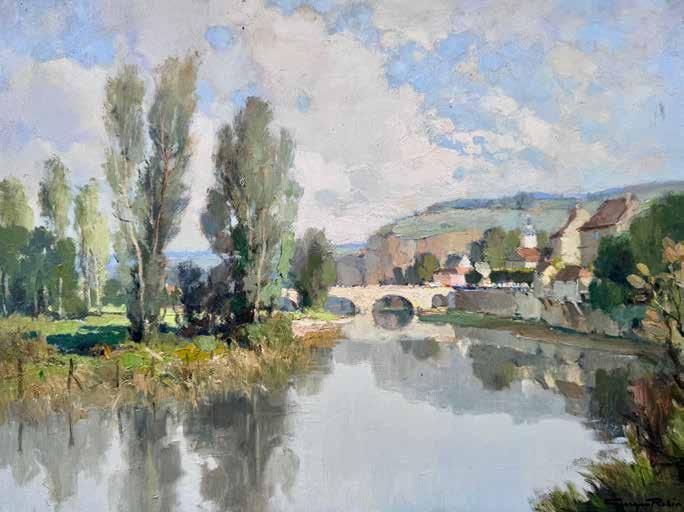
£17,500
£17,500
La Vézère au Bugue, Dordogne, c. 1960
Oil on Canvas
46 x 61 cms / 18" x 24"
Sur le Fusain près de Château-Landon, c. 1970
Oil on Board
46 x 61 cms / 18" x 24"
Georges Charles Robin French (1903-2002)
Robin’s Awards and Honours
1948, French Landscape Prize, Paris Salon.
1948, Premier Prize, Salon des Paysagistes Français.
1954, Gold Medal, Paris Salon.
1954, Selected to be a member of the Jury, Salon des Paysagistes Français.
1954, Selected to be a member of the Jury, Salon d’Hiver.
1954, Selected to be a member of the Committee of Directors, Salon d’Hiver.
1954, Gold Medal, Salon des Artistes Français.
1954, Selected to be a member of the Jury, Salon des Artistes Français.
1954, Received the Hors-Concours, Salon des Artistes Français.
1954, Silver Medal, Salon des Artistes Français.
1958, Prize of the Town of Clichy.
1958, Prize of the Town of Asnieres.
1959, Premier Award, Salon du Printemps.
1960, Premier Award, Salon Levallois.
1961, Awarded Prix Taylor, Salon des Artistes Français.
1961, Awarded Bronze Medal, Salon des Artistes Français.
1961, Awarded Silver Medal, Conseil General de la Seine.
1961, Awarded Gold Medal, Société d’Arts, Sciences et Lettres.

Georges Charles Robin French (1903-2002)
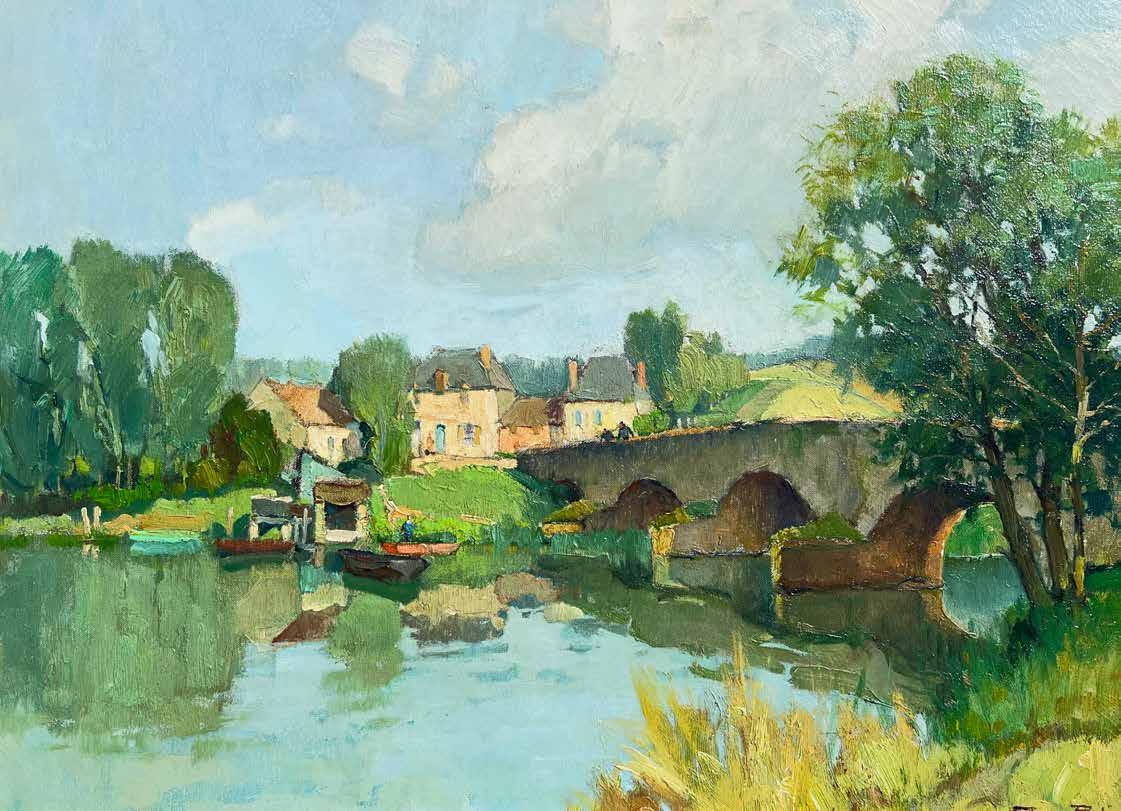
La Sarthe près du Mans
Oil on Canvas
50 x 61 cms / 20" x 24"
£18,500

Georges Charles Robin
French (1903-2002)
46 x 38 cms / 18" x 15"
£12,500

La Sèvre Nantaise vers Mallièvre, c. 1945
Oil on Canvas
Georges Charles Robin French
(1903-2002)

33 x 41 cms / 13 x 16¼ inches
£9,950

33 x 40 cms / 13 x 15 ¾ inches
£7,950
L'Aveyron à Bruniquel, c. 1955
Oil on Canvas
Panorama sur Eze et le Cap d’Ail, c. 1965
Oil on Canvas
Georges Charles Robin
French (1903-2002)
60 x 81 cms / 23½ x 32 inches
£25,000
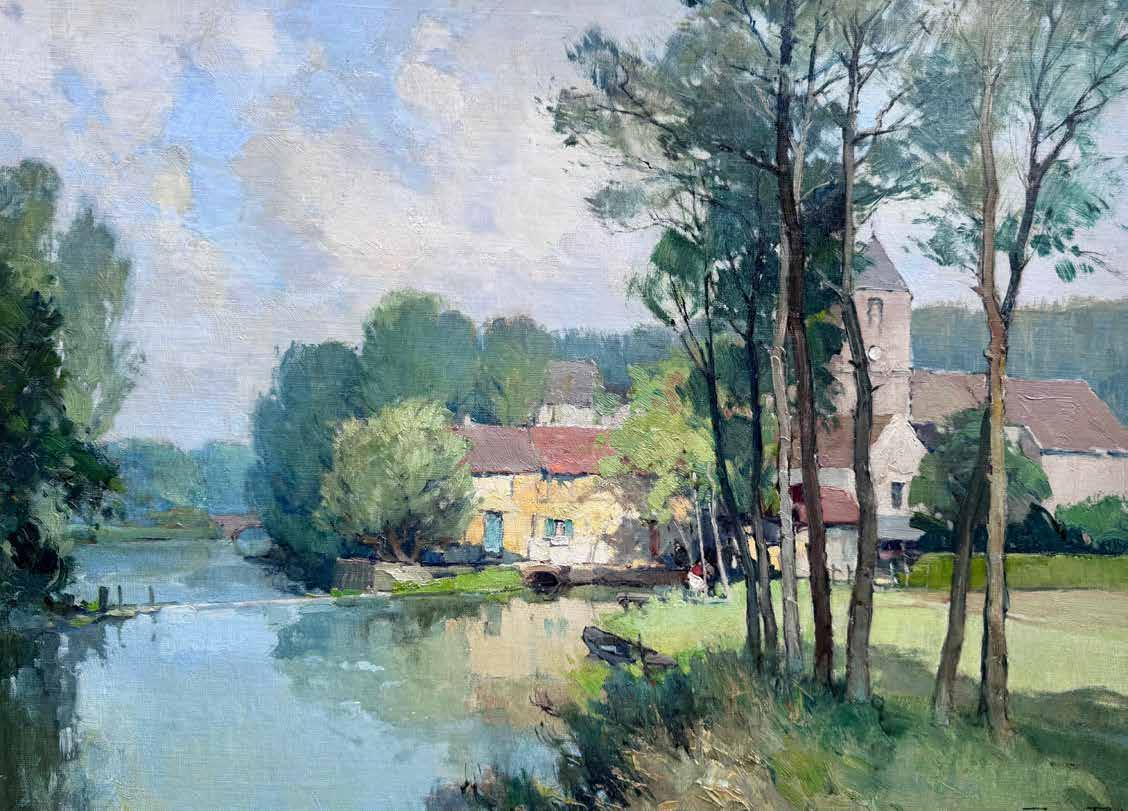
La Cure, Affluent de L’Yonne à Sermizelles, c. 1975
Oil on Canvas
Georges Charles Robin French
(1903-2002)

51 x 65 cms / 20 x 25½ inches
£17,500
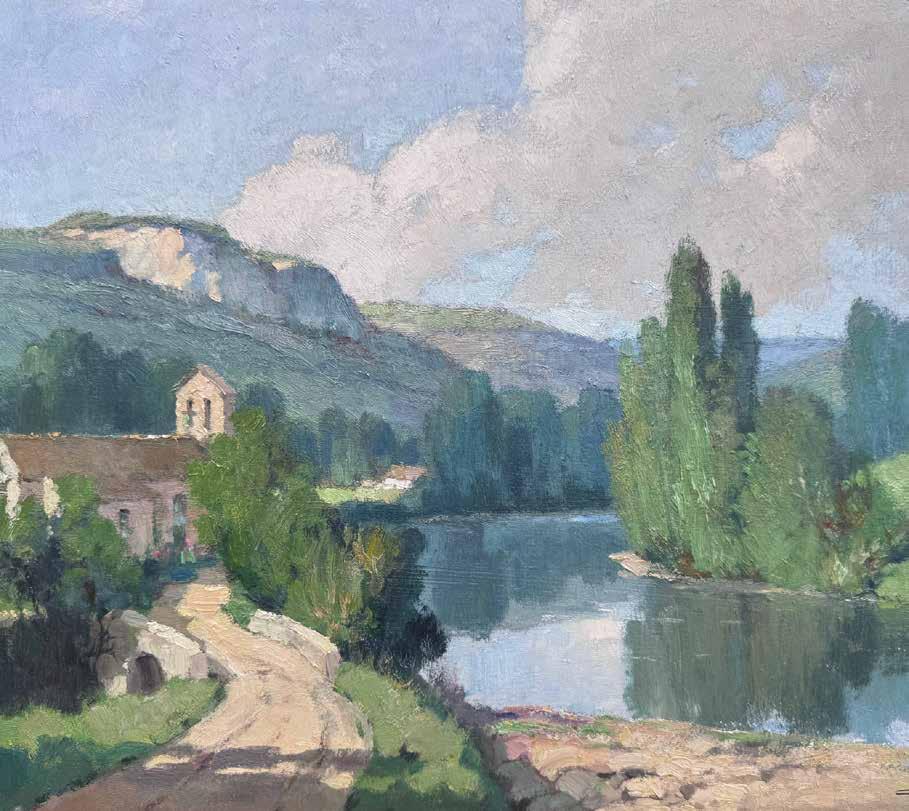
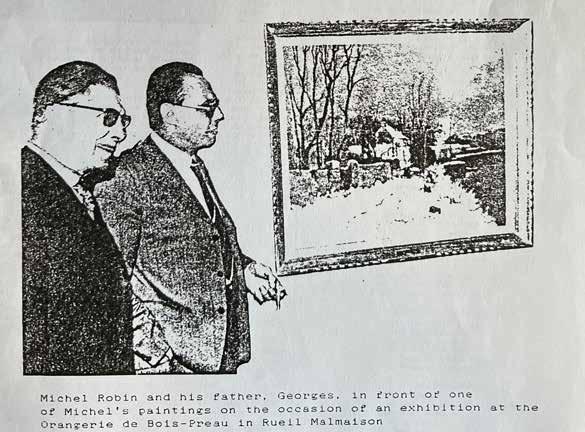
L'Aveyron à Montrozier, Eglise Romane du XIIème siècle, c. 1960
Oil on Canvas
Post Impressionist School
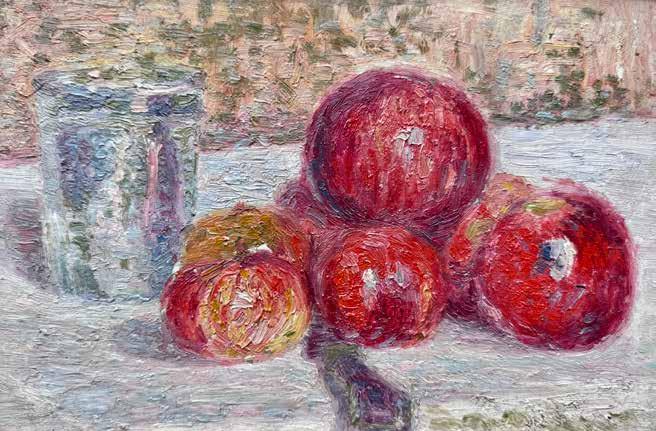
18.5 x 27.5 cms / 7¼ x 10¾ inches
£1,950
Edward Atkinson Hornel British, (1864-1933)
Two Young Girls Picking Flowers

40.5 x 51 cms / 16 x 20 inches
Oil on Canvas
£15,000
Composition au Verre et aux Fruits
Oil on Board
Sir Peter Scott
British, (1909-1989)
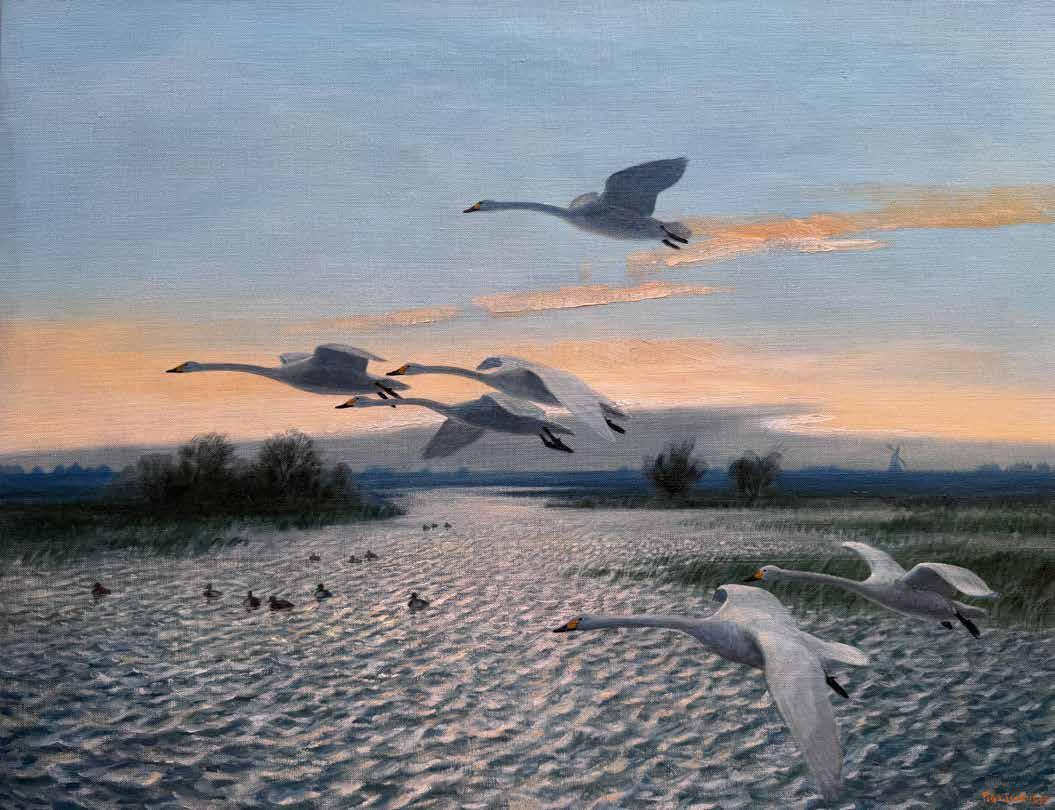
Swans in Flight, 1957
Oil on Canvas
72.5 x 91.5 cms / 28½ x 36 inches
£30,000
Paul S. Brown p 15
Gustave Cariot p 20-27
Edouard-Leon Cortes p 64-67
Paul S. Brown p 52-55
James Doran-Webb inside front cover
Marcel Dyf p 37
Andre Hambourg p 58-61
Adrien Hamon p 62-63
Edward Atkinson Hornel p 103
Alexandre Louis Jacob p 68-71
Henri Le Sidaner p 38-47
Gustave Loiseau p 28-35
Pierre Eugène Montézin p 16-19
Post-Impresionist School p 102
Georges Charles Robin p 82-101
Edward Seago p 50-53
Sir Peter Scott p 104-105
David Shepherd p 54-57
Anthony Theakston p 72-81
Raymond Thibesart p 36
Edward Waites p 14
Raymond Wintz p 48-49


